

SAT Test Sections 2023: Comprehensive Format Breakdown

Aaron • Last updated on January 5, 2023

Are you taking the SAT in a few months? Or, maybe you just want to know what this test is all about? Either way, it is a great idea for you to know its content. If you’re taking the test soon, you’re probably asking:
What does the SAT consist of?
What sections are on the SAT?
How is the SAT structured?
In this article, we break down the SAT according to structure, time breakdown, section times, and question types. Each section measures different skills and abilities, so answering them requires different approaches. We will then look at some tips on how to perform well in each section of the SAT.
So, what’s on the SAT?
Different SAT sections
The SAT is administered to measure how much you learned in high school and to assess your readiness for college. As mentioned, it tests your skills and abilities in different aspects.
There are four SAT test sections:
- Writing and Language
- Essay (optional)
The Math section has two parts: No calculator and With Calculator. Aside from the Essay section, which you may or may not take, all questions on the admissions test are in a multiple-choice format.
How many questions are on the SAT? There are a total of 154 questions + 1 essay question.
The total SAT time is 3 hours if you skip the essay and 3.50 hours if you answer it.
Now, let’s break down the SAT format.
SAT Breakdown
The table above shows the SAT breakdown of sections, their corresponding number of questions, and SAT time per section.
As you can see, the Math section covers the biggest chunk of the SAT test length with 58 questions. It also covers most of the SAT time length with 80 minutes in total.
What does the SAT test you on? First and foremost, the SAT measures your readiness for college. If we get down to specifics, however, you will see particular topics that are covered.
Check out the chart below to see the different question types you are going to encounter on the test. Also, indicated in the table is the breakdown for scoring on the SAT.
The scoring range for the whole SAT is 400-1600, and the scoring range for each section is 200-800. The optional Essay section’s scoring range, on the other hand, is 2-8.
The SAT Reading Section
Let’s look closely at each section of the SAT and the skills being measured in each one.

The first section of the SAT is the Reading section. It measures how well you can absorb, process, and use information. It will test your reading comprehension skills, as well as your understanding of vocabulary in context.
In the SAT Reading section, you will be given 5 passages:
- 1 passage from a classic or contemporary work or world literature
- 1 passage from a U.S. founding document or a text in Global Conversation they inspired
- 1 passage on social sciences
- 2 passages on science
Each passage or set of passages is about 500-750 words long. Some of these come with an infographic, chart, or graph, in which you will be asked to interpret data. There’s also a possibility of having paired passages, which discuss the same theme or topic.
What are the SAT test types for reading? Let’s expound on them one by one.
Reading question types
1. big picture/little picture.
This type of question will ask you what the main point or the purpose of the passage is. What is the passage about? What is it trying to tell you? A big picture type of question will measure your ability to identify the general idea of the passage.
On the other hand, a little picture type of question will ask you what the purpose of a specific line(s) is/are. What you’ll do here is find evidence that will support the purpose of a specific line or the passage as a whole.
2. Inference
In this type of question, you are asked to basically interpret the meaning of a line or a set of lines. Sometimes, you will be asked to interpret the meaning of the whole passage.
3. Vocabulary/context
Questions on vocabulary don’t need much explaining. This type of question asks you to define a word from the text. However, some words are used in an unusual way, so comprehension is key.
4. Author Analysis
This type of question will ask you to identify and analyze the author’s technique and style of writing. You will be asked about the author’s tone, voice, point of view, and the like.
5. Evidence support
Questions on evidence support will require you to find evidence to support your answer to the previous question. You will have to look for specific lines on the text to answer it.
6. Data Interpretation
As mentioned, some passages will come with sets of data, charts, or a graph. With that said, some questions will ask you to interpret data and identify how it is related to the passage.
Tips and Strategies on answering the Reading Section
1. read, read, and read..
Since we’re talking about the reading section, is there any better way to practice than reading passages? Read those that are provided in the College Board’s official practice tests ( 1 ). Those are the closest you can get to the actual passages given during the SAT.
You should not just simply read those passages, however. As you practice, make sure that you consider how fast you are reading them. The SAT is a timed exam, so you should balance your time reading the 5 passages with the given time for the section. This, of course, should be done without sacrificing your comprehension of the text.
Good sources of passages for reading are The New York Times and The Atlantic. Most passages on the SAT were adopted from these sources.
2. Work on dual passages one at a time.
Dual passages are common on the SAT. These are two shorter passages that are related to each other. One tip in answering the Reading section is to take dual passages one at a time.
It is recommended that you answer questions about the first passage first, then you answer questions about the second passage next. Lastly, you answer questions on both passages. With this, you can avoid confusing the two texts and mixing ideas.
3. Process of elimination
One of the best strategies in answering the Reading section is to eliminate answers that are obviously incorrect. There are four choices for each question, and only one is correct. The other three choices will show clear signs that they are incorrect. Some even have no connection to the question or do not make sense at all. It is a great idea to eliminate these choices.
The SAT Writing and Language Section

The Writing and Language section of the SAT is similar to the Reading section because it also deals with passages. Unlike the Reading section, however, it’s not your reading comprehension skills that are being tested. Rather, it will measure your skills in identifying and correcting grammatical errors.
The passages you’ll encounter in this section are of the same nature as the ones in the Reading section. They cover topics like history, social sciences, humanities, and even career. However, these passages can come in the form of narratives or arguments.
Writing and Language question types
Here are the types of questions that you can expect to encounter in the Writing and Language section of the SAT:
1. Command of Evidence
This type of question will ask you if a particular change or addition to the text should be done. However, it is not just a matter of yes or no. You must find the right evidence on why you should or should not make that specific change.
2. Word change
Questions on word change will ask you which word from the choices would best replace a specific word from the text. There is also a “NO CHANGE” option for this type of question if you believe that there is no need to replace the word on the text.
3. Arrangement of ideas
This type of question will require you to rearrange or combine statements/sentences on the text. Basically, your job will be to find the most appropriate way to combine or rearrange the statements or sentences.
4. English conventions
English-conventions-related questions will ask you to choose a particular phrase or sentence that is more grammatically correct than the underlined one. For this type of question, you will need to have good knowledge of English grammar, punctuation, capitalization, and sentence structure.
Questions on English conventions cover almost half of the SAT Writing section, so you should focus on them as you prepare for the test.
Tips and Strategies on answering the Writing and Language section
1. work on the questions as you read the passages.
The SAT Writing section is composed of 44 questions and has a time allotment of 35 minutes. This means the average time for answering a question is 48 seconds. For more efficient answering, it is recommended that you already identify the error (if there is one) on the underlined phrases or sentences as you read the passage.
2. Choose a relevant but concise answer
There will be instances when you think that two choices would both make complete sense. In this case, try to choose a more concise option. One of the objectives in answering the Writing and Language section is to eliminate wordiness.
3. Master grammar and punctuation rules
As mentioned earlier, questions on English conventions cover a huge chunk of the SAT Writing section. If you want to get a high score on this particular part of the test, it is necessary for you to master your grammar and punctuation skills. You should know the proper usage of commas, colons, semicolons, dashes, and apostrophes.
4. Read well-written essays
One of the best ways to prepare for the Writing and Language section of the SAT is to read plenty of articles and essays. Newspapers, journals, magazines, and persuasive essays are among great types of text to read.
Reading well-written essays will help you familiarize proper grammar and punctuation rules, as well as the proper arrangement or organization of topics, ideas, and sentences.
The SAT Math Section

From words and passages, let’s get into numbers! The Math section is the third section on the SAT. Obviously, it is nothing similar to the first two sections.
It is divided into two parts: no calculator and with a calculator. The first part, where you will not be allowed to use your calculator, will run for 25 minutes and will consist of 20 questions.
For the second part of the Math section, you will be allowed to use a calculator that is approved by the College Board ( 2 ). The SAT calculator section is composed of 38 questions, and the SAT test time for it is 55 minutes.
Both sections will begin with questions in a multiple-choice format, then you will be asked for student-produced responses known as “grid-ins”.
Questions in the Math section deal with practical and real-world mathematical topics that are essential to your college years.
The chart below shows the different areas covered by the Math section and their corresponding number of questions.
Math question types
1. heart of algebra.
Algebra covers most of the SAT Math section. It deals with:
- Systems of equations
- Linear equations
- Expressions
- Inequalities
- Absolute values
- Rearrangement and interpretation of formulas
2. Problem Solving and Data Analysis
These types of questions are found in both no calculator and with calculator sections. Here, you will be asked to analyze relationships and interpret data. The sets of data that you will analyze will come from charts, graphs, tables, and the like. Moreover, you will deal with rates, ratios, proportions, percentages, and probability.
3. Passport to Advanced math
Passport to Advanced Math questions will measure your understanding of the structure of expressions. You will also be required to rewrite and rearrange these expressions and equations. In these types of questions, you will deal with:
- Quadratic equations
- Exponents and exponential functions
- Manipulation of polynomials
4. Additional topics in Math
The last question type, which also covers the least number of questions in the Math section, is Additional Topics in Math. It covers topics in:
- Trigonometry
- Volume calculations
- Investigating lines
Tips and Strategies in answering the Math section
1. understand the concepts.
The truth is, you won’t get a high score in the Math section if you just focus on strategies. You have to understand the basic concepts in Mathematics to be able to answer the questions.
While reviewing, make sure that you understand how to arrive at a certain answer. You may be able to memorize all the formulas needed, but if you do not know the concept behind them, you can only get too far.
2. Memorize common formulas
If the Math section is war, mathematical formulas are your weapons. To get a high score, you will need to memorize formulas ( 3 ) on areas, volumes, right triangles, percentages, probabilities, and other topics in the Math section.
3. Plug and play
One of the best strategies in answering the Math section is a direct substitution of choices. Whenever you have no idea at all how to solve a particular problem or expression, you can plug in the choices one by one.
It is recommended that you plug in the middle choices first (B or C), so you’ll know if you should substitute higher or lower values.
The SAT Essay Section (Optional)
The last section of the SAT is the Essay section. While it is optional, some colleges and universities require applicants to answer it. So make sure to check if the school you want to enroll in wants to see your score in this part of the exam.
What skills are measured in the Essay section?
In this section, you will be given one passage consisting of 650-750 words. Your job here is to respond to the passage by analyzing the author’s arguments. You will be asked to examine the author’s claims and how the arguments are presented.
Your task for the Essay section is not to simply write about what the passage is about. The task is also not about presenting your own opinions about the topic. The Essay section requires you to analyze how the author built their claims and arguments. To do this, you will have to use examples from the passage itself.
Tips and strategies in taking the Essay section
1. be objective.
As mentioned earlier, it is not your task to share your own opinions about the topic of the passage or what the author is saying. Instead, your job is to analyze the author’s arguments. With that said, it is important that you stay objective and not be influenced by personal feelings or opinions. It is also recommended that you avoid using the words “I” and “You”.
2. Consider the structure
One of the best characteristics of a great essay is that it follows the proper structure. Always remember the structure of an essay, which includes an introduction, body, and conclusion.
Here’s what we recommend you to write in each part of your essay:
- Introduction – Describe the text and paraphrase the author’s argument. Also, introduce the elements of the passage.
- Body – Describe how the author presented the arguments. Discuss how the author assembles the arguments to make a point or support the overall claim.
- Conclusion – Restate the goal of the passage and sum up the points that you made.
3. Keep it clean
Your essay will be handwritten, so it is important that you write legibly in such a way that it will be easy for the scorers to understand your essay. If the Essay scorers happen to not understand your penmanship, regardless of how good your content is, they will give you a low score. So, always remember to keep it tidy.
Frequently Asked Questions
THE SAT has 5 sections: 4 mandatory and 1 optional. The SAT sections are Reading, Writing and Language, Math (No calculator and with a calculator), and Essay (optional).
The SAT Reading, Writing, Math sections combine for a total of 154 questions. The Essay section (if you take it) has one passage/question. The total SAT length is 3 hours for those not taking the Essay section and an additional 50 minutes for those who will answer it.
Final thoughts
There you have it, the complete breakdown of the SAT sections for 2020. Different sections of the admissions test measure different skills and abilities to assess how much you learned in high school and how prepared you are for college.
Use this breakdown to guide you on what to study and focus on when preparing for the SAT. All information, tips, and strategies presented on this article are based on the College Board’s official full-length practice tests. Application of these tips and strategies will surely boost your confidence and preparedness on the test day.
Now that you have all the information on the SAT sections, what’s next? The next thing to do is to apply the information and strategies on your preparation for the SAT. At the end of the day, it’s not just your knowledge of the sections that will help you on the exam. Constant practice and discipline in studying will help bring your A-game on the test day. Good luck!
- https://collegereadiness.collegeboard.org/sat/practice/full-length-practice-tests
- https://collegereadiness.collegeboard.org/sat/taking-the-test/calculator-policy
- https://blog.prepscholar.com/critical-sat-math-formulas-you-must-know

What are your chances of acceptance?
Calculate for all schools, your chance of acceptance.
Your chancing factors
Extracurriculars.
The SAT Writing Section (Essay): Here’s What You Need to Know

Is your SAT score enough to get you into your dream school?
Our free chancing engine takes into consideration your SAT score, in addition to other profile factors, such as GPA and extracurriculars. Create a free account to discover your chances at hundreds of different schools.
The SAT recently revamped itself to more accurately test what students learn in school. The new version is less deliberately tricky and confusing, but it’s still a challenging, exhausting test. Let’s say you’ve taken both the ACT and the SAT and you perform better on the SAT. Now that you’ve chosen it as your go-to test, how do you get through the essay portion, especially if you hate writing?
Fun fact: the SAT has plenty of new practice tests , which include essays. For the purposes of this post, I’ll be working from this practice essay , so it might be useful to have it open as you read. We’ll go through what’s expected, what scoring looks like, and how to go about writing the best essay you can.
Understand What You’re Being Asked to Do
The new SAT no longer asks you to make up ideas and references from scratch (which, honestly, is probably for the best). Instead, it provides you with an essay and asks you to analyze it, much in the same vein as an in-class analytical or an AP English Language essay.
The Assignment
The assignment reads as follows. At the top you’ll see a generic introduction for what to look for as you read:
As you read the passage below, consider how (the author of the passage) uses:
- evidence, such as facts or examples, to support claims.
- reasoning to develop ideas and to connect claims and evidence.
- stylistic or persuasive elements, such as word choice or appeals to emotion, to add power to the ideas expressed.
Then, at the bottom, the instructions get specific. For this essay, they read like this:
Write an essay in which you explain how Bobby Braun builds an argument to persuade his audience that the US government must continue to invest in NASA. In your essay, analyze how Braun uses one or more of the features listed in the box above (or features of your own choice) to strengthen the logic and persuasiveness of his argument. Be sure that your analysis focuses on the most relevant features of the passage. Your essay should not explain whether you agree with Braun’s claims, but rather explain how Braun builds an argument to persuade his audience.
What does this mean? Essentially, as you read, pick out the techniques the author uses to make his or her point, then write a detailed essay that covers a couple of the main ones. Brush up on your knowledge of literary terms and devices well in advance of writing the SAT essay. You don’t have to know them all, but know the most commonly used ones really well (tone, diction, imagery, simile/metaphor, allusion, rhetorical question, anecdote, and symbolism, to name a few) so you can rely on those. In an argumentative essay, like this one, an author will always use tone, diction (choice of words), and some kind of persuasion technique (Logos? Pathos? Ethos? Anecdote? etc.).
How is the essay scored? Two testers will read your essay and will provide a score of 1-4 on three different benchmarks: reading, analysis, and writing.
Did the writer understand the content? Did they quickly summarize the argument/point and then move quickly into their interpretation of it? Did they paraphrase and directly quote?
Did the writer not only identify the right literary terms/devices but assess their uses effectively? In other words, did the writer understand why the author used those devices and say so? Did the analysis integrate into the rest of the essay?
Is there a strong thesis, body paragraphs for each device, and a quick conclusion? (More on organization below.) Is the writing “strong,” i.e., sentence variety, no unnecessary words or repetition, strong words, and sophisticated reasoning?
The testers’ scores are then added together for an aggregate final score. So, a top score would be 8/8/8.

Discover how your SAT score affects your chances
As part of our free guidance platform, our Admissions Assessment tells you what schools you need to improve your SAT score for and by how much. Sign up to get started today.
Final Thoughts
Unless you’re being given extra time, you have exactly 50 minutes to complete the essay. This sounds like a lot (and it’s more than it used to be), but don’t be fooled. You’ll use the time.
Students with special accommodations might be able to take the test on a computer, but otherwise it’s a written test. Your test booklet will be scanned into a computer. If you make a mistake, don’t erase your work, because it causes smudges and can make it hard for the tester to read. Simply cross out and rewrite. The testers are trained not to read crossed-out material. If you’ve been told your handwriting is impossible to read, write a little more slowly than you might otherwise. Choose the style that’s more legible for you: print or cursive. When you write practice tests, give it to someone and ask if they can read it.
You’ll take the SAT essay last, after every other section has been completed. So you’ll be exhausted. There’s no way around that, unfortunately, beyond bringing snacks and water on test day and walking around during breaks to take the focus off your brain for a couple minutes. Practice is key; you’ll want to be able to read an essay quickly, pull out devices, and write a straightforward essay with a minimum of confusion and anxiety. Only practice and memorization of the right information will get you there.
As you prepare to take the SAT, take a look at some example essays that scored highly. It won’t be the same subject matter, but the structure and language will be aspects you can emulate.
Read with the Assignment in Mind
Imagine that your proctor has told you to turn to the essay section. You already know the basic assignment, so you can actually skip the top introduction and dive right in to the essay. Don’t get bogged down with unfamiliar words or the most complex sentences. You don’t need to absorb every single word of the essay. Read to find devices you can use. Circle them and ID them as you go. Don’t be picky right away—just observe and note what you see.
Go ahead and skim the bottom instructions, but even then the first sentence is the only really important one. In this case, the gist is: how does Braun persuade his audience to invest in NASA? Then, go back to the devices you found, and pick out the three strongest and/or most used devices to structure your essay. Can’t find three? Remember, an author always uses tone (point of view) and diction (word choice) so those are two easy ones if you’re stuck.
The process of reading and pulling out devices should take no more than eight minutes.
Make a Quick Outline
I know this one sound counterintuitive, given what I said about time limits, but bear with me. Just starting to write without a clear path is hugely problematic for timed essays. Even the best writers make a mental note of their general direction. Without planning, you might change directions mid-essay, forget your thesis and end up arguing something else, or wander off completely without realizing it.
The outline can be short and sweet. For example, with this practice essay, it could look like this:
Intro: Braun argues that continuing to invest in space tech and research keeps us competitive in the world economy. Devices: logos, imagery, allusion
Body 1: Logos (logic): paragraph 3, 5, 7
Body 2: Imagery: paragraph 4, 6
Body 3: Allusion: paragraph 8
Don’t even bother to include your conclusion in your outline. It’s pretty much the same content as your intro. Also, remember that you don’t need to tackle every aspect or device in the essay. Highlight where your devices are, then focus your analysis to those sections. In the outline above, I’ve structured the devices so that you’re going through the essay in almost chronological fashion. You don’t have to do this, but it makes the essay-writing a bit easier.
The process of outlining should take no more than two minutes.
Write Quickly but Methodically
Don’t waste a lot of breath with a big, drawn out introduction. State the argument of the author in one sentence, then your thesis, which should be a list of the three devices you plan to use. Keep it simple and easy, then move on.
For each body paragraph, make a quick topic sentence explaining which device you’re analyzing. Spend one sentence (ONLY one) summarizing how the author is using the device. Begin to use quotes or paraphrase; after each example, analyze why the author uses the device and the effect it has. About three quotes or examples are usually standard. Then, at the end of the paragraph, use one sentence to sum up the effect the device has on the whole essay. Use sample essays for examples of this structure.
See the numbers at the side of each paragraph? When you quote directly or summarize directly, put the number of the paragraph in parenthesis afterwards to cite where you’re getting the information from.
For your conclusion, simply restate what you’ve said before. If you’re feeling extra-confident, feel free to add a key takeaway from the analysis, but it’s not necessary. So, your conclusion can be two sentences just like your intro.
What if your writing style isn’t advanced or similar to the example essays? Work with a teacher or tutor who can help you develop your skills if you have the time. If not, just write simply and clearly. Don’t use overly technical words. Don’t make really long sentences just for the sake of doing so. Even simple, forceful language can be effective so long as your argument is good. So focus your attention on ensuring that you know what good analysis is and how to replicate it.
You’ll have 35 minutes to write. Keep an eye on the clock, but mostly just focus on writing quickly and clearly.
Leave a Few Minutes for Proofreading
Again, I know you’ll be flying through this essay at lightning speed to get everything done effectively. But this one’s important too. When you write quickly, grammar and spelling can fall by the wayside. That’s totally normal, so don’t freak out. But you will be graded on such aspects in your final score, so leave 5 minutes max at the end to skim through your essay, pinpoint where you made mistakes, cross out the word or phrase, and write the correct word or phrase above it. Try to make corrections clearly so that the tester knows which version to read.
And that’s it! Easy, right? (Totally kidding.) As with everything else, practice will help. If you’re not already doing this kind of essay in class, do a few practice essays at home. Make sure you do the EXACT process start to finish: time yourself, write an outline, and so on. Part of success is building the muscle memory to go into the essay with a solid base of experience and confidence that you’ll succeed.
Want to know how your SAT score impacts your chances of acceptance to your dream schools? Our free Chancing Engine will not only help you predict your odds, but also let you know how you stack up against other applicants, and which aspects of your profile to improve. Sign up for your free CollegeVine account today to gain access to our Chancing Engine and get a jumpstart on your college strategy!
Related CollegeVine Blog Posts

If you're seeing this message, it means we're having trouble loading external resources on our website.
If you're behind a web filter, please make sure that the domains *.kastatic.org and *.kasandbox.org are unblocked.
To log in and use all the features of Khan Academy, please enable JavaScript in your browser.

Upcoming Changes to the SAT for 2023 and 2024
In January 2022, the College Board (CB for brevity) announced a sweeping revamp of the SAT, its flagship college admissions test. The changes took effect for non-US testers earlier this year (2023), and they’ll be implemented for domestic testers at the beginning of 2024. These adjustments are the most dramatic shift in the world of high school standardized testing since… the last time the SAT reinvented itself, in 2016.
Sarcasm aside, the upcoming changes are substantial, and they will affect the way students prepare for the SAT to a commensurate degree. With many rising juniors now beginning the process of choosing and preparing for either the SAT or the ACT, your friendly neighborhood test experts are here to cover the changes to the SAT coming in 2024: what’s changing, what’s staying the same, and how it affects you. Let’s dive in.
An Overview of the Current SAT
The SAT is one of the two standardized tests utilized by colleges during the admissions process, with the other being the ACT . Comprised of four sections that contain a mix of multiple-choice questions and grid-in math problems, the SAT has a maximum possible composite score of 1600 points. The test bordered on a mandatory rite of passage for high school juniors and seniors for many years; despite the current proliferation of test-optional admissions policies prompted by the COVID-19 pandemic, a large number of aspiring college freshmen still sit for the SAT each year, oftentimes more than once.
The structure of the current version of the SAT is as follows:
SAT Structure Through December 2023
Until recently, there was an optional fifth section of the test that was comprised of one essay prompt; however, that Writing section was eliminated a couple of years ago, and it is currently only administered on School Day testing dates in specific states.
What Are the SAT Changes for 2023 and 2024?
Now that we’ve covered the structure of the current paper-and-pencil SAT (which is still available to US-based students for 5-6 more months), let’s discuss the changes that are coming at the beginning of next year. Here are the high-level SAT changes that American students can expect to see starting in 2024.
(Note that we’re not diving into all of the content and question-type changes within each individual section; I’ll be covering that more rigorously in a future post.)
Digital Format
The first and most obvious change is that the new SAT will be an entirely digital test. The test will be administered through the Bluebook testing app, which must be downloaded to the student’s device prior to test day. This means no more bubble sheets and no more #2 pencils—just a laptop or tablet, which can be either a personal device that you bring to the testing center or a loaner device that you borrow from College Board or your school for the test.
Fewer (Types of) Sections
As I outlined above, the current paper-and-pencil SAT has four different section-types: Reading, Writing & Language, Math No Calculator, and Math with Calculator. The new digital SAT, however, will have only two: Reading & Writing and Math. Because there will be two modules of each of these two section-types, the total number of sections will remain at four; however, the number of different sections you need to prepare for will be cut in half.
See below for a table containing more details about the breakdown of the new section structure.
Shorter Test
Though the number of sections that makes up the test isn’t changing, you’ll notice if you compare the two tables above that the new version of the SAT will be significantly shorter: 2 hours and 14 minutes of testing time for the digital test compared to 3 hours of testing time for the current paper-and-pencil test. If you’re anywhere close to as lazy as I was in high school, this will be music to your ears.
Adaptive Structure
One of the less visible but still significant changes coming with the digital SAT is the introduction of a section-adaptive test structure. This means that for each of the two section-types (Reading & Writing and Math), the first module will contain questions of a range of difficulty levels in order to allow the system to assess the student’s ability; then, the second module of each section-type will be selected from two options (a harder version and an easier version) by the testing algorithm based on the student’s performance on the first module.
In layman’s terms, this means that if you crush the first Math or Reading & Writing module, you can expect to see harder questions on the second; if you struggle with the first module of either section-type, your second module of that section will contain easier problems.
New Calculator Usage Options
Calculator lovers, rejoice—the day you’ve been waiting for has arrived. Whereas the current SAT has one calculator-active Math section and one calculator-inactive Math section, both Math modules on the digital SAT will be calculator active, which means that you don’t have to do a single operation in your head anymore.
Not only that, but the Bluebook testing app has a version of the Desmos graphing calculator built into its interface. This is a major win for students who aren’t especially quick at doing things like adjusting the window and finding intersection points on their personal graphing calculators, as Desmos makes those actions extremely intuitive.
And an underrated part of the new policy is that you don’t have to choose one calculator or the other: you can bring your personal calculator to do arithmetic operations if that’s easier for you, then pull up the in-app Desmos calculator for any graphing-related questions. This promises to be a substantial improvement for students who are on the lookout for opportunities to let the calculator do some of the heavy lifting for them.
SAT Changes Coming in 2024: What’s NOT Changing?
If it wasn’t clear from everything I listed above, the SAT in March 2024 is going to look VERY different from any of its previous iterations. With that being said, however, not everything will be changing when the test shifts from paper-and-pencil to digital; in fact, there are quite a few things that will be remaining the same. Below is a list of the biggies.
- No changes to testing locations: For a hot minute during the height of the COVID lockdown, College Board had big plans to roll out at-home SAT testing for students across the globe; however, those plans have been put on hold for at least the foreseeable future. Though the new SAT will be entirely digital, it will still be administered only at schools or at approved test centers.
- No changes to scoring scales: The mechanics of SAT scoring will be changing with the rollout of the digital test. Instead of depending solely on how many questions you get correct in each section, as is the case with the current scoring system, your score will also depend on the difficulty level of the questions you get right, as well as which module they were in. On a macro level, however, the overall scaled scores that students receive after all the calculations are done will look exactly the same: a Verbal (Reading & Writing) score with a max of 800 and a Math score with a max of 800, which are added together to create a composite score with a max of 1600.
- No changes to mechanics of question format: Though the new SAT will introduce some new question-types, the composition of the test in terms of question mechanics will remain more or less the same: the Reading & Writing section will consist entirely of multiple-choice questions with four possible answers, and the Math section will consist of ~75% multiple-choice questions and ~25% student-produced-response (grid-in) questions. The only real change here is the fact that grid-ins on the digital SAT will sometimes have negative answers.
- No changes to accommodations: Documentation released by College Board states that the digital SAT will “offer students with disabilities the same range of accommodations available in the paper-based suite”; the process for requesting those accommodations will also remain the same. CB’s documents also indicate that students who require a paper-based test due to a disability will still be able to access one upon receiving approval.
SAT Changes Coming in 2024: How Do They Affect You?
Reactions to all of this information will likely vary depending on the individual test-taker. I’ve worked with a number of students who would have loved to take the test on a computer, as the migration of school assignments and activities to the digital realm, which was accelerated by COVID, made them more comfortable working in that medium. On the other hand, I also know many students who value the ability to interact with the test by writing in the booklet, particularly in the Reading section.
If you fall into the latter category, I wouldn’t worry too much: reading passages on the new SAT will be substantially shorter than on the current test and will only have one question associated with them rather than 10-11, which should limit the amount of annotation that feels necessary while you read. Additionally, you’ll still have access to scratch paper on the digital test, so you’ll be able to take notes as you read even if you can’t mark directly on the passages.
One aspect of the new SAT that almost nobody is likely to complain about is the shorter testing time. A shorter test means more of your Saturday to enjoy, but it also means less mental fatigue while you’re testing; if you’re someone who tends to feel noticeably less sharp at the end of a 3-hour test than you do at the beginning, you may very well feel that your performance improves once the SAT changes in 2024.
Another consequence of the digital test format that should be universally popular is a much shorter turnaround time for scores. College Board has stated that the waiting period for testers to receive their scores should now be “days instead of weeks”; this will allow students to make decisions about repeat testing sooner, which will in turn give them more time to prep for that next test.
Finally, digital tests are more secure than paper-and-pencil tests in a number of ways. Because testers can’t return to a section once they complete it—not like “you’re not supposed to”, like “you literally can’t access it anymore”—less honest students will be unable to do things like discuss questions from previous sections during the break, then go back into the testing room and change their answers. This is a positive development for the vast majority of students who didn’t try to game the system in that way.
SAT Changes Coming in 2024: When Do They Take Effect?
As I’ve alluded to at different times in this post, the rollout for the new digital SAT suite is a multi-stage process. The new test has actually already been rolled out for international students: it began to be administered in non-US locations in spring of 2023. For domestic students, the PSAT will utilize the new digital format this year (2023-2024) for the first time; then, starting in spring of 2024, the SAT will transition to its new digital form. From that point on, the current paper-and-pencil test will no longer be available.
See below for a graphic that summarizes the timeline for the rollout of the new test.
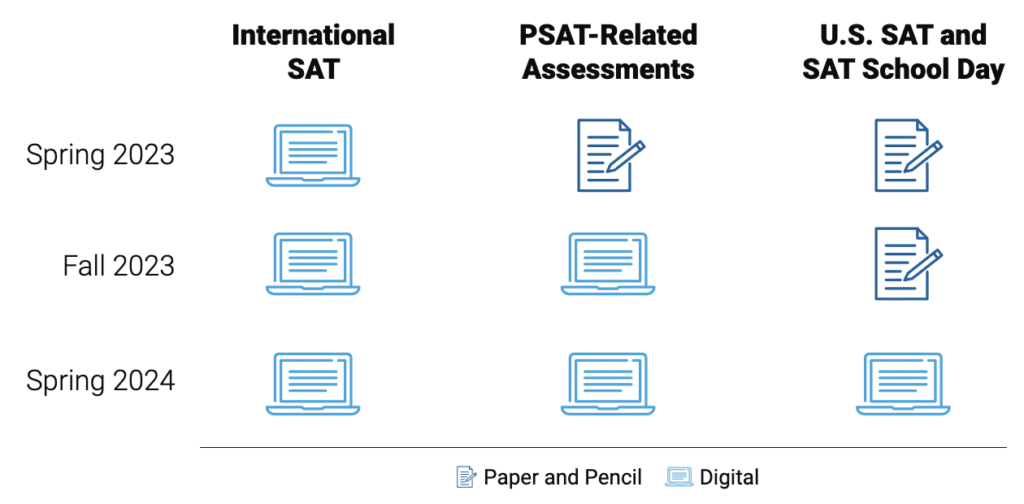
Source: The Digital SAT Suite of Assessments Specifications Overview , Page 3
SAT Changes Coming in 2024: How to Prepare
Rising high school juniors who are starting to think about test prep are in an interesting spot right now as they decide on their best plan of action: instead of simply choosing between SAT and ACT, they’re now choosing between current SAT, new SAT, and ACT. If that applies to you, here are the main options you have and a few things to consider about each one.
Start Prepping Now and Take the Current SAT
Though the shift to the digital SAT looms large on the horizon, there are still four test dates remaining in 2023 for the current iteration of the SAT: August, October, November, and December. This means that students who are nervous about being guinea pigs for the domestic implementation of the new test still have time to prepare, test multiple times, and hopefully earn a score they’re happy with.
If that’s your plan, however, I would highly recommend starting the process ASAP. Though there is a good amount of overlap between the current SAT and the new SAT in terms of content and question-types, there are also significant differences; this means that if you get caught in a situation where you want to continue testing as the calendar rolls over into 2024, you’ll have some new material to prepare for that you wouldn’t have needed to worry about otherwise.
The advantage of taking this path is that there are a ton of materials out there for the current version of the SAT. You’ve got eight official practice tests hosted on College Board’s website , as well as a number of third-party resources (albeit of inconsistent quality) and even some unofficial previous tests floating around the internet. This provides you with plenty of ammo to get the process of preparing for and taking the SAT out of the way before the changes coming in 2024.
Wait to Prep Until the New SAT Arrives
If you don’t think you’ll realistically be able to earn an SAT score that meets your needs in the next 5-6 months, your next option is to wait for the rollout of the new test.
If you’re considering this route, note that you’ll probably want to delay starting to prep until closer to the end of 2023 because of the dearth of practice materials currently available for the digital SAT. As of now, there are only four adaptive digital practice tests available through the Bluebook app and four linear practice tests hosted on the College Board website; since the linear and adaptive tests pull from the same question pool, you’ll probably even notice some overlap between them, which means that these materials don’t really constitute eight unique tests. Khan Academy does also have some prep material for the new SAT, but it’s very limited.
The upshot of this is that it will be very hard to make this content last until the first digital test date in March 2024. It’s likely that there will be new practice material produced over the coming months, both by College Board and by third-party companies, but currently there’s simply not much. Make sure you’re timing your prep to ensure that you have enough material to be practicing consistently until your test date.
Take the ACT Instead
The final path you can choose is to totally disregard the changes to the SAT coming in 2024 and simply prep for the ACT instead. The ACT is a very different test in several ways, prioritizing problem-solving under time pressure over in-depth content knowledge; however, it’s just as learnable as the SAT, and often even more so for students who are able to read and process quickly. There is also a ton of high-quality practice content available, which means that most students won’t need to worry about running out of materials.
_ _ _ _ _ _ _ _ _ _ _ _ _ _ _
Whichever path you choose, we’d love to help you achieve your best possible score. Reach out today to learn more about how the Pros can help you beat the old SAT, the new SAT, or the ACT.
Looking To Improve Your Score on the SAT or ACT?
Sat changes coming in 2024: final thoughts.
We’ve covered a lot of ground today: changes to the structure and delivery of the SAT coming in 2024, aspects of the test that we know will not be changing significantly, and how all of this affects you. There will very likely be new information released over the coming months; if so, rest assured that they’ll lock me back in this dark room until I write something about it, so make sure you check back regularly for any new updates.
SAT Changes Coming in 2024: Frequently Asked Questions
Is there still an essay on the new sat.
Nope, you’ve dodged this particular bullet once again. The essay portion of the SAT was largely discontinued in 2021, and there are no indications that the digital SAT will be bringing it back.
Will the upcoming changes to the SAT make it easier?
It largely depends on the test-taker. There are changes coming to the test that many students will likely appreciate: reading passages will be shorter, students will have access to a calculator for the entirety of the Math section, and total testing time will decrease by more than 25%. This may make the test feel easier to many students; however, remember that your SAT scaled scores are calculated based in part on the performance of other students. If more students are consistently getting more questions correct, the bar for earning a high score will rise.
Is it still worth taking the SAT?
For many students, yes. Though most colleges and universities have moved to a test-optional admissions policy as a result of the COVID pandemic, test scores can still help you show admissions officers that you fit what they’re looking for in an incoming freshman. Look up the median SAT scores for the schools in which you’re most interested—if you believe that you can earn a score that’s at or above that 50% mark, it’s often a good idea to take the test.
Why are colleges dropping the SAT?
How much time do you have? The short answer is that most of them aren’t. With a few notable exceptions (looking at you, University of California system), the majority of schools have gone test-optional, not test-blind. This means that they don’t require you to submit scores with your application, but they will still consider them if you do. This upsurge in test-optional policies was largely caused by concerns about the ability of students to take the SAT safely during COVID, but it’s also the result of a series of debates about the utility of standardized tests that have been going on for years.
SAT Changes Coming in 2024: Related Reading
What’s a Good SAT Score For 2023?
What Calculators Are Allowed on the SAT?
An Overview of SAT Costs & Fees
Understanding the Differences Between the ACT & SAT
Do I Need the SAT For College? Deciding Whether or Not to Take the SAT
RECENT POSTS

ACT and SAT Score Comparison: Score Conversions and Chart

ACT Test Dates 2024: Upcoming Test Dates & Deadlines for the ACT Exam
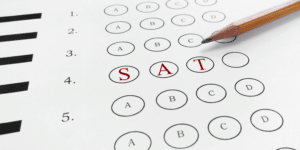
How To Check Your SAT Score: A Step-By-Step Guide

Sign Up For the Latest News
- 60 Chelsea Piers Ste 6020, New York, NY 10011
- [email protected]
- 844 663 9484

All About the 2023 Digital SAT

The SAT is now transitioning into a digital model. It will only be administered in this format starting March 2023 for all students who are taking the test outside of the US. For students taking the test in the US, this format will be administered March 2024. Registrations for the digital SAT in India will begin Fall 2022.
According to the College Board, changes are made to address the concerns with access because of COVID and the lack of equity in the SAT. This has let a large number of colleges stop using SAT scores as part of their admissions. These changes are made in the hope of making the test easier and shorter to narrow the performance gaps and restore the usefulness of the SAT as an assessment for college readiness.
The test will be administered through a specially designed exam application called Bluebook (https://about.collegeboard.org/bluebook-technology), which a student will have to download before test day. The student can take this test either on their laptop or tablet. Internationally, SAT will now be administered seven test dates a year as compared to the current five.
The below information is all you need to know about the new SAT from 2023 onwards. The SAT will become fully digital—and shorter—in 2023. Here's what's changing and what's staying the same.
What's changing?
The newest version of the SAT will look and feel different in several key ways:
- The test will last for about two hours (shrinking by one hour)
- There will be two sections—a Reading & Writing section and a Math section—instead of four.
- Reading passages will be shorter, and students will answer only one question per passage.
- Word problems in Math will be more concise.
- Students will take the test on a laptop or tablet.
- A digital testing app will need to be downloaded before test day. The digital testing app should save students' progress while they work, even if they lose internet access or their computer crashes.
- Students will have access to a series of tools through the digital testing app, including a timer, a calculator, a reference sheet, and a flagging tool to mark questions for review.
- Students can use a calculator on the entire Math section.
- The test will be adaptive. Each section will begin with an introductory module. A student's performance on that first set of questions will determine the difficulty level of the subsequent questions they see.
- Scores will be released sooner. Students will receive their scores in days instead of weeks.
- There will be two more test dates for international students.
What's staying the same?
Some aspects of the SAT will remain the same:
- Students will take the test at a school or test center, not at home.
- Scores will be out of 1600. Each section (Reading & Writing and Math) will be scored on an 800-point scale.
- Both sections will feature multiple-choice questions. The Math section will also include questions that students must answer by entering their solutions directly into the app.
- Accommodations will be available to students who need them.
The digital SAT will be divided into the following two sections:
- Reading and Writing
The following image describes the new digital SAT format and the differences with the older version of the SAT:

Some of the other key changes are the following:

Authorized use of calculators
The current SAT divides the math section into two parts: a non-calculator and a calculator portion. But as part of the recent changes, a calculator is now allowed for the entire math segment.
Students can either bring their own graphing calculator or use one that's embedded into the exam, which experts say reduces test day barriers.
Expedited score results
Rather than waiting weeks to get results, students will receive score reports from the digital tests in a matter of days.
Reports have typically included percentile rankings and a breakdown of a student's score. They've also provided information about four-year colleges and scholarship opportunities. Under the new format, the College Board plans to expand that to include resources about local community colleges, workforce training and career options, Rodriguez says.
Impact of the SAT Changes
With the SAT being considered a "high stakes" exam, many students feel pressure to perform well. But in a November pilot launch of the digital version, 80% of participants found the new format to be "less stressful" than the paper test, according to the College Board.
"What I hope and want is for students to be able to come in and just focus on demonstrating what they've learned and what they can do in the core reading, writing and math areas," Rodriguez says. "And (to) have a lot of the stress around the test, the rigidity, the policies, all melt away."
Stay tuned for further information about the new digital SAT.
You Might Also Like

Brainstorming for College Essays
This Article is intended to help you brainstorm and begin writing your personal statement essay and all the other college essays. This is a key step to write persuasive college essays

The Secret Behind Early Applications
If you are serious about taking admission to your dream university/college, early decision admission program is best option for you, have a look! - AP Guru

Know How to Build a Great College List
Want to choose best college for your study? Get some amazing guidelines that will help you to create a great college list for your admission - Read our blog

Free Resources
The Optional SAT Essay: What to Know
Tackling this section of the SAT requires preparation and can boost some students' college applications.

Getty Images
Even though an increasing number of colleges are dropping standardized test requirements, students who must write the SAT essay can still stand to gain from doing so.
Although the essay portion of the SAT became optional in 2016, many students still chose to write it to demonstrate strong or improved writing skills to prospective colleges.
In June 2021, the College Board opted to discontinue the SAT essay. Now, only students in a few states and school districts still have access to — and must complete — the SAT essay. This requirement applies to some students in the SAT School Day program, for instance, among other groups.
How Colleges Use SAT, ACT Results
Tiffany Sorensen Sept. 14, 2020

Whether or not to write the SAT essay is not the biggest decision you will have to make in high school, but it is certainly one that requires thought on your part. Here are three things you should know about the 50-minute SAT essay as you decide whether to complete it:
- To excel on the SAT essay, you must be a trained reader.
- The SAT essay begs background knowledge of rhetoric and persuasive writing.
- A growing number of colleges are dropping standardized test requirements.
To Excel on the SAT Essay, You Must Be a Trained Reader
The SAT essay prompt never comes unaccompanied. On the contrary, it follows a text that is about 700 words long or approximately one page. Before test-takers can even plan their response, they must carefully read and – ideally – annotate the passage.
The multifaceted nature of the SAT essay prompt can be distressing to students who struggle with reading comprehension. But the good news is that this prompt is highly predictable: It always asks students to explain how the author builds his or her argument. In this case, "how” means which rhetorical devices are used, such as deductive reasoning, metaphors, etc.
Luckily, the author’s argument is usually spelled out in the prompt itself. For instance, consider this past SAT prompt : “Write an essay in which you explain how Paul Bogard builds an argument to persuade his audience that natural darkness should be preserved.”
Due to the essay prompt’s straightforward nature, students should read the passage with an eye toward specific devices used by the author rather than poring over “big ideas.” In tour SAT essay, aim to analyze at least two devices, with three being even better.
The SAT Essay Begs Background Knowledge of Rhetoric and Persuasive Writing
Since your SAT essay response must point to specific rhetorical devices that the author employs to convince the reader, you should make it a point to intimately know 10-15 common ones. The more familiar you are with rhetorical devices, the faster you will become at picking them out as you read texts.
Once you have read the passage and identified a handful of noteworthy rhetorical devices, you should apply many of the same essay-writing techniques you already use in your high school English classes.
For instance, you should start by brainstorming to see which devices you have the most to say about. After that, develop a concise thesis statement, incorporate quotes from the text, avoid wordiness and other infelicities of writing, close with an intriguing conclusion, and do everything else you could imagine your English teacher advising you to do.
Remember to always provide evidence from the text to support your claims. Finally, leave a few minutes at the end to review your essay for mistakes.
A Growing Number of Colleges Are Dropping Standardized Test Requirements
In recent years, some of America’s most prominent colleges and universities – including Ivy League institutions like Harvard University in Massachusetts, Princeton University in New Jersey and Yale University in Connecticut – have made submission of ACT and SAT scores optional.
While this trend began as early as 2018, the upheaval caused by COVID-19 has prompted many other schools to adopt a more lenient testing policy, as well.
Advocates for educational fairness have long expressed concerns that standardized admissions tests put underprivileged students at a disadvantage. In light of the coronavirus pandemic , which restricted exam access for almost all high school students, colleges have gotten on board with this idea by placing more emphasis on other factors in a student’s application.
To assess writing ability in alternative ways, colleges now place more emphasis on students’ grades in language-oriented subjects, as well as college application documents like the personal statement .
The fact that more colleges are lifting their ACT/SAT requirement does not imply that either test or any component of it is now obsolete. Students who must write the SAT essay can still stand to gain from doing so, especially those who wish to major in a writing-intensive field. The essay can also demonstrate a progression or upward trajectory in writing skills.
The SAT essay can give a boost to the college applications of the few students to whom it is still available. If the requirement applies to you, be sure to learn more about the SAT essay and practice it often as you prepare for your upcoming SAT.
13 Test Prep Tips for SAT and ACT Takers

Tags: SAT , standardized tests , students , education
About College Admissions Playbook
Stressed about getting into college? College Admissions Playbook, authored by Varsity Tutors , offers prospective college students advice on Advanced Placement and International Baccalaureate courses, SAT and ACT exams and the college application process. Varsity Tutors, an advertiser with U.S. News & World Report, is a live learning platform that connects students with personalized instruction to accelerate academic achievement. The company's end-to-end offerings also include mobile learning apps, online learning environments and other tutoring and test prep-focused technologies. Got a question? Email [email protected] .
Ask an Alum: Making the Most Out of College
You May Also Like
Nonacademic factors in college searches.
Sarah Wood May 28, 2024

Takeaways From the NCAA’s Settlement
Laura Mannweiler May 24, 2024

New Best Engineering Rankings June 18
Robert Morse and Eric Brooks May 24, 2024

Premedical Programs: What to Know
Sarah Wood May 21, 2024

How Geography Affects College Admissions
Cole Claybourn May 21, 2024

Q&A: College Alumni Engagement
LaMont Jones, Jr. May 20, 2024

10 Destination West Coast College Towns
Cole Claybourn May 16, 2024

Scholarships for Lesser-Known Sports
Sarah Wood May 15, 2024

Should Students Submit Test Scores?
Sarah Wood May 13, 2024

Poll: Antisemitism a Problem on Campus
Lauren Camera May 13, 2024

You are using an outdated browser. Please upgrade your browser to improve your experience.

The SAT Essay 2022-2023: What to Expect
Last updated: March 2022
How to write the SAT essay:
- Read the prompt to understand the task.
- Read the sample passage, underlining the examples and evidence.
- Come up with a thesis statement.
- Outline your SAT essay.
- Write a draft.
- Edit it: check arguments and evidence, make sure there’s a logic in the essay.
- Proofread your SAT essay: check grammar, spelling, sentence structure, etc.
Good news for those afraid of SAT essays:
This section is optional now. It means they won’t require you to write the SAT essay this year.
Many colleges still recommend it to see your writing and critical thinking skills.
What are those colleges that require SAT essays? How long is the SAT with essays? How to write it? And what is the SAT essay, after all?
Keep on reading to find out all the details, and get ready to earn the highest score for your essay this year.

Source: Unsplash
That’s what you’ll learn in this guide:
Table of Contents:
- Organization
- The SAT essay: to take or not to take?
- How to decide when to take the SAT
- How to register for the SAT
- Top changes to SAT essays in 2022
- How to write SAT essay?
- SAT essay tips
- Colleges that require SAT essay
What is the SAT?
Invented by Carl Brigham in 1923 , the SAT is owned and developed by College Board. It’s a not-for-profit organization in the USA, with over 6,000 schools, colleges, and universities being its members.
SAT Purpose
The purpose of the SAT is to measure your readiness for college. It’s focused on the knowledge and skills you’ve got in high school, and it provides colleges with one common score to compare all applicants.
College admission officers review the SAT score alongside with your other achievements such as:
- Your high school GPA.
- The admission interview.
- Your personal essay .
- Letters of recommendation from your teachers.
- The classes you took in school.
- Your extracurricular activities.
The higher your final score, the more options you’ll have for admission.
SAT Organization
The SAT includes three mandatory parts: Reading, Writing, and Math. As per 2016, an SAT essay is optional for applicants to take, though many colleges still require it.
You’ll have three hours to complete your SAT (without the essay). If you write the essay, you’ll have 3 hours 50 minutes to finish the whole test.
To succeed with the test, you should complete its all sections. If you leave some questions unanswered, your scores will be canceled.
The total you can get for your SAT is on a scale of 400–1600, with 200–800 for each of two sections: Reading and Writing + Math.
Sounds difficult?
Okay, here’s a kinda SAT score calculator for you:
If you write an SAT essay, you can get an extra 2–8 points for each of three criteria. What are these criteria, and what is a good essay score?
Two graders from College Board score each SAT essay on a scale of 1-4 across three criteria:
- Reading: it should be clear from your essay that you’ve understood the material. So, cover its main points and show how they interrelate.
- Analysis: an essay should include persuasive claims about the text’s main points. So, evaluate them and provide supporting evidence for its claims.
- Writing: an essay should be structured well. So, present your arguments logically, vary sentence structure, state a thesis, and avoid grammar/spelling mistakes.
Summed together from two graders, your SAT essay score can range between 2 and 8 for each criterion.
In 2018, the average SAT essay score was 5 out of 8 for Reading, 4 out of 8 for Analysis, and 5 out of 8 for Writing. ( Source )
As you see, the analysis was the most challenging part for students. That’s because it differs from what you do in standard essays:
In high school, you mostly write persuasive essays to give your personal opinion on the topic. In the SAT essay, they ask you to analyze the author’s opinion. It’s more like writing an expository essay . And although the structure of SAT essays doesn’t differ from that of a standard essay, it may be difficult for you to logically link the arguments and evidence of another person in a new paper.
SAT Dates in 2022-2023
As a rule, the SAT takes place on the first Saturday of November, December, May, and June. Other dates include late January, March or April, and late August or October.
In other words, you can take the exam almost every month. Just make sure you are ready and don’t miss a registration deadline for your chosen data.
Here are the SAT dates for 2022-2023:
The SAT Essay: to Take or Not to Take?
As you’ve read already, an SAT essay is optional now. However, there are many colleges and universities in the USA that still require it from applicants. So, if you decide not to write the SAT essay, you won’t be able to apply to these schools.
Later in this article, you’ll find the list of colleges that require the SAT essay. Make sure yours is not there; otherwise, you’ll have to write an essay. If you are still unsure of what college to apply, writing the essay would come in handy anyway.
The SAT with essay costs $57 as opposed to the $45 for the SAT without an essay section.
Pros and cons of taking the SAT essay:

How to Decide When to Take the SAT
Think strategically when choosing the date for taking your SAT:
- How much time do you need to prepare? Map it out, set goals, visualize your plan – and you’ll know what SAT date fits you best.
- How busy are you with other tasks at the moment? With tons of other assignments and commitments to complete, you’ll hardly find enough time for preparation. So, choose the season when your schedule is not that crazy.
- What is your college application timeline? You’ll need the SAT completed before you submit the application, so time accordingly.
How to Register for the SAT
First of all, choose the date, based on the tips above. Try to complete your SAT registration as soon as possible, because the late registration usually needs an extra fee.
Also, decide if you take the SAT essay. For that, find out if your chosen colleges require such essays. Also, check if they ask applicants to take SAT Subject Tests (they are given by College Board on individual subjects).
You can complete the registration on the College Board website , or fill in the Student Registration Booklet and send it by email. ( Ask your school counselor for this booklet .)
You’ll need to upload a picture of yourself and provide all your personal data. Make sure the photo and info match with those in your ID. Also, pay a registration fee.
Once your registration is complete, print out the Admission Ticket: you’ll need it when come to take your test.
Top Changes to SAT Essays in 2022
In case you don’t know, the SAT has changed since 2016. Many educational blogs and websites wrote about it because it was the year of the biggest change to this test, and it impacted students greatly.
Time, format, scores, sections… Everything is different now!
Here go the most significant changes to SAT essays in 2020 and later:
- The SAT essay is optional now.
- Students have 50 minutes for writing it. (The old SAT gave them only 25 minutes.)
- This essay is argumentative now, and it asks you to analyze another essay. (The old SAT required to answer a theoretical prompt in your essay.)
- The SAT essay is scored separately now. (The old SAT had an essay as a part of the Writing section, and the score range for it was 200-800.)
More changes to the overall SAT test are gathered and turned into the infographic by Student Tutor. Check here for details.
Or, let’s turn to SAT essay examples!
That’s what an SAT essay task looked back in 2016:
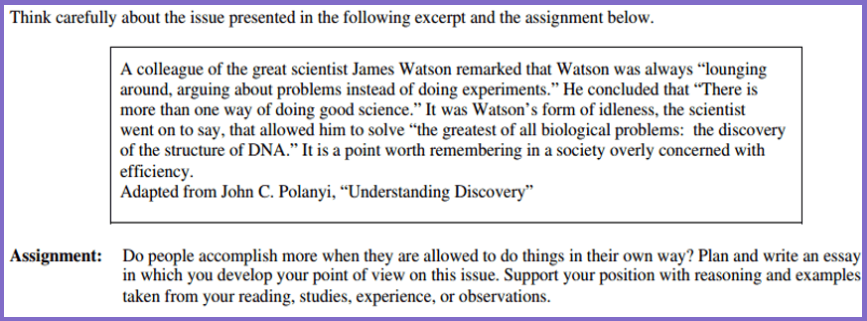
As you see, it’s focused on a more theoretical response. Graders didn’t estimate any analytical skills.
And that’s the example of a new SAT essay task:

It requires a more argumentative and analytical approach from students. Graders can see your critical thinking skills, not just your personal opinion on a given theoretical prompt.
Both examples are taken from Allen Cheng’s article at PrepScholar. He shared the complete guide to the SAT new rules and its most meaningful changes for students.
How to Write SAT Essay?
Below, you’ll find SAT essay tips that can help to improve your scores. But now let’s turn to an essay structure and your step by step tutorial on how to write SAT essays.
Lucky you are, the SAT essay structure is similar to any standard academic paper teachers asked you to write in class. Known as a 5-paragraph essay , its basic parts are:
- Introduction: 2-3 sentences with a hook and a thesis statement.
- Thesis statement: a central argument of your essay, so take your time to craft it.
- Supporting paragraphs (two or three, if time) : each of them should include a topic sentence, evidence, and a concluding sentence to demonstrate how it refers to your thesis statement.
- Conclusion: 3-4 sentences, summarizing your arguments in a concise manner.
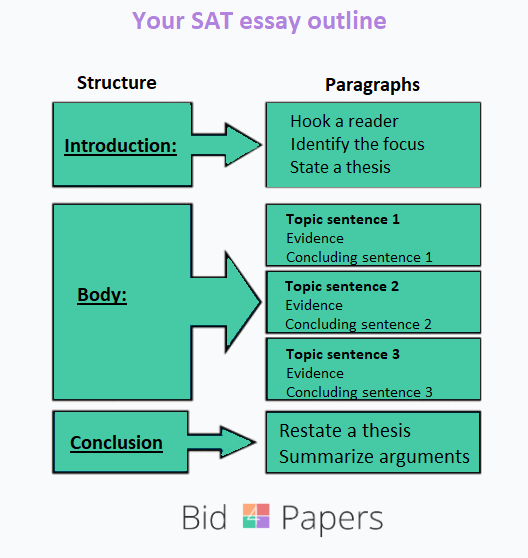
Given that you have 50 minutes for writing the SAT essay, make sure to allocate this time like a boss:
- Read the prompt: 1 minute .
- Read the passage, annotating the core info: 15 minutes .
- Outline the essay: 5 minutes .
- Write an essay: 25 minutes .
- Check an essay: 4 minutes .
Don’t hurry up to read the passage: pay attention to the task (prompt) itself, as it will help you understand what information and evidence to concentrate. So, here we have the first step to writing a good SAT essay: read the prompt before the passage .
After that, read the sample passage carefully . Underline the evidence and examples you can use to answer the prompt in your essay. Remember, that your SAT essay will be scored for Reading , so you’ll need to demonstrate that you understand the text’s main points.
To get a high score for Analysis , you’ll need to explain and evaluate the author’s arguments. So, when reading the passage, identify his central claim and instruments he uses to support it (reasoning, evidence, stylistic elements). Focus on the most relevant and persuasive ones.
State your thesis . It should sum up your assessment of the author’s argument. Make it concise and clear, but don’t add any personal attitudes. Remember: you analyze the author’s view rather than share your own. Stay objective when reading the passage and then creating your central claim.
Now it’s time for outlining your essay. Map out it briefly in the introduction, then specify topic sentences and evidence for each paragraph of your essay’s body. Write the draft , with an essay conclusion restating your thesis and summarizing the whole paper.
Check your SAT essay: make sure to use effective language and word choice. Use a variety of sentence structures but stay clear and informative. Your essay gets scores for Writing too, and high scores go to works that are “cohesive and demonstrate highly effective use and command of language.” ( Source )
Source: Giphy
So, avoid low-level vocabulary, correct all spelling and grammar mistakes, and check if you use the right transitional phrases to describe relationships between the arguments in your essay.
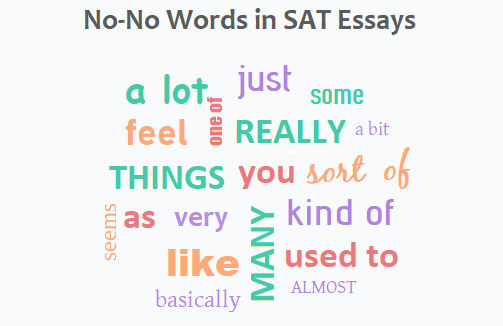
SAT Essay Tips
Everyone loves tips, especially if they help to achieve goals and conquer new peaks. And when your goal is a high score for an SAT essay, you need tips more than ever. No wonder:
Who doesn’t want to get a magic bullet to hit the target at one stroke, right?
We asked our team of professional academic writers to give readers their recommendations on essay writing, and here go the essay tips they’ve shared:
What you can do to earn high scores for the SAT essay:
- Understand the scoring system.
- Study essay samples; analyze their structure.
- Practice a lot: take sample prompts and spend 50 minutes on writing essays based on them.
- Learn to analyze texts and see central claims and evidence in them.
- During the SAT, read the prompt before the passage. Always.
- Use accurate facts: support your points with evidence from the passage.
- Be objective: answer the prompt but don’t add any personal opinion or points.
- Take your time to organize the SAT essay, and don’t forget to revise it.
- Make your essay longer than one page: though they say length doesn’t matter, your short response might be not enough for graders to see your writing skills — and you score for the Writing criterion will suffer.
- Follow standard tips for essay writing: use straightforward language, give a clear thesis, structure your essay logically.
- Use a timer when practicing your SAT essay: remember that you’ll have 50 minutes only, so make time for analyzing, planning, writing, and revising it.
Colleges That Require SAT Essay
Your decision to take the optional SAT essay might heavily depend on which college you are going to apply.
So, let’s check what colleges require SAT essays. If yours isn’t in the list, feel free to catch a break: you won’t have to prepare for this writing test and spend money on taking it. However, we would recommend you to double-check with each school at their official websites. (Rules change, you know, and the information tends to go out of date in time.)
We took the most popular colleges among US students only. If your school isn’t on the list, check SAT essay policies of all educational institutes at the official College Board website.
SAT Essay Examples
As mentioned, you need to practice a lot to write the SAT essay worth a high score. That’s true. But what else you can do is pre-plan the examples and evidence you’ll use in the essay! For that, analyze SAT essay examples available online.
Yes, the specifics of your prompt will differ; but they can help choose the types of examples you’ll use to explain the author’s argument.
College Board shares many SAT essay examples with detailed analysis and explanations of why they gave these or those scores to students. They’ll help you understand what to expect from your essay and what writing weaknesses of yours to improve.
This is the SAT essay example that has got 2/1/1 from graders.
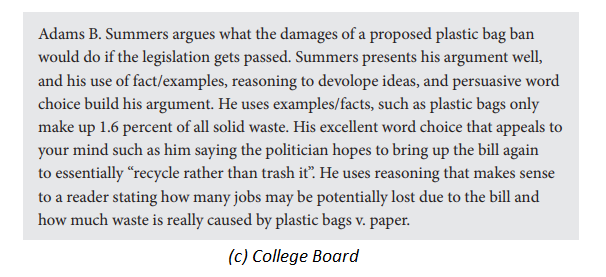
(Oops, you better don’t write like that!)
And this work has got 4/4/4 points! See the difference:

(c) College Board
Additional Resources to Check:
- The SAT Student Guide 2022, College Board
- SAT Essay Practice on Khan Academy
- Practice With a Redesigned SAT Essay Prompts
- Best Books to Prepare for SAT
- SAT Essay Prompts: The Complete List
Related posts
- What Is the Difference between Primary and Secondary Sources
- Common Types of Plagiarism with Examples
- Exemplification Essay – Ideas and Tips
Our Writing Guides

LSAT Argumentative Writing

LSAT Argumentative Writing SM
A new approach to the Writing section of the LSAT
Beginning July 30, 2024, LSAT Argumentative Writing will replace the LSAT Writing prompt that has been part of the LSAT since 1982.
This new approach to the writing assessment aims to assess a test taker’s ability to construct a cogent argument based on a variety of evidentiary sources. Test takers will be presented with a debatable issue, along with three or four perspectives that provide additional context for the issue. These perspectives, each of which is conveyed in a few sentences, are representative of a system of beliefs or values. Together, the perspectives illustrate competing ideologies and arguments around a particular issue. The test taker will then draft an argumentative essay in which they take a position on the issue, while addressing some of the arguments and ideas presented by the other perspectives.
The new argumentative writing task is designed to give test takers a clearer, more authentic writing purpose than the former “decision-based” LSAT Writing prompt, which was more narrowly focused on pure logical reasoning. When test takers have an opportunity to construct an original thesis and defend it based on their own judgment and analytical evaluation, rather than following pre-ordained lines of reasoning, we can better assess the broader and more complex range of decision-making skills that writers engage in.
By adopting this design, we’re not only enabling individuals to have a more authentic voice in their argument, but we are also better positioned to evaluate the writer’s ability to employ various rhetorical techniques, evidentiary strategies, and other important aspects of argumentative writing.
Given the additional reading load required by the new writing task format, LSAT Argumentative Writing will include a short preparatory period that test takers can use to organize their thoughts using guided prewriting analysis questions and to take notes using the digital notetaking tool provided in the testing environment. These questions are designed to help test takers analyze the various perspectives and generate productive ideas for their essay. Most test takers will have a total of 50 minutes — 15 minutes for prewriting analysis and 35 minutes for essay writing. Test takers with approved accommodations for additional time will have their time allocations adjusted accordingly.
For the 2024-2025 testing cycle, LSAT Argumentative Writing will remain an unscored section of the LSAT and will be administered exclusively in an online proctored, on-demand environment using secure proctoring software that is installed on the test taker’s computer.
Quick Facts about LSAT Writing
Online administration.
Before You Begin — Top Tips
If your LSAT Argumentative Writing session is flagged for further review, it may delay the release of your LSAT score. Review these tips to avoid having your session flagged.
Required for LSAT Scoring
LSAT Argumentative Writing samples are not scored, but LSAT Argumentative Writing is a required part of the LSAT. Your LSAT score cannot be released to law schools if you do not have a completed and approved LSAT Argumentative Writing sample on file .
Take a Practice Writing Prompt
Through your free LSAC LawHub account, you have access to an official LSAT Argumentative Writing practice prompt that can help you prepare for test day. This writing prompt is representative of the kind of prompts that are used in the LSAT Argumentative Writing assessment. You can use this prompt to get familiar with both the content and the interface of the test.
You can sign into LawHub with your LSAC username and password.
Testing Accommodations
Through our deep commitment to disability rights, LSAC will continue to address the needs of all individuals with disabilities who require testing accommodations. We will make every effort to ensure all test takers are able to fully demonstrate their skills when they take the LSAT and LSAT Argumentative Writing.
Learn More about testing accommodations
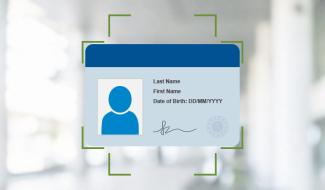
Learn How to Verify Your ID on Test Day
When you launch valid, government-issued photo ID . We’ve compiled a list of tips, so you’ll know what to do (and not do!) when it’s time to photograph your ID on exam day. If your LSAT Writing sample is flagged due to ID issues, it could delay the release of your LSAT score.--> LSAT Argumentative Writing, you’ll need to take a photo of your valid, government-issued photo ID. Please ensure that the photo of your ID is clear and recognizable. Images of IDs that are blurry, out of focus, or unrecognizable will not be accepted, and your writing sample will be canceled. Please review the image of your ID on your screen for clarity before capturing the image.
Review ID Requirements
Frequently Asked Questions
How do i register for lsat argumentative writing.
If you’re taking the LSAT for the first time, one administration of LSAT Argumentative Writing is included in your LSAT registration. By registering for the LSAT, you will be automatically eligible to complete the writing section, which is open eight (8) days before you take the multiple-choice portion of the LSAT. You can access LSAT Argumentative Writing from your LSAC JD Account.
NOTE: The LSAT registration fee includes both the multiple-choice portion of the LSAT and LSAT Argumentative Writing. There are no additional fees associated with LSAT Argumentative Writing.
When can I take LSAT Argumentative Writing?
Candidates are eligible to take LSAT Argumentative Writing starting eight (8) days prior to their LSAT administration. For your LSAT to be considered complete, you will need to take the LSAT Argumentative Writing section of the test if you do not already have a writing sample on file from a previous LSAT administration. Most law schools require a writing sample as an integral part of their admission decision, and therefore, you should complete a writing sample to meet schools’ application deadlines. Your writing sample will be shared with the law schools to which you have applied once it’s approved and your score is released. Candidates will be required to have a completed writing sample in their file to see their test score or have their score released to law schools.
How long does it take to complete the LSAT Argumentative Writing task?
Most test takers will have a total of 50 minutes — 15 minutes for prewriting analysis and 35 minutes for essay writing. Test takers with approved accommodations for additional time will have their time allocations adjusted accordingly. Test takers can use the 15-minute prewriting analysis to organize their thoughts using guided prewriting analysis questions and to take notes using the digital notetaking tool provided in the testing environment. These questions are designed to help test takers analyze the various perspectives and generate productive ideas for their essay. All test takers will have the option to move past the prewriting analysis after 5 minutes of time have expired, or they may choose to use their full time allocated.
By when do I have to complete LSAT Argumentative Writing?
If you do not have a writing sample on file, we encourage you to complete LSAT Argumentative Writing as soon as you can. LSAT Argumentative Writing opens eight (8) days prior to every test administration. Candidates must have a complete writing sample in their file in order to see their score or have their score released to schools. Most law schools require a writing sample as an integral part of their admission decision, and therefore, you should complete the writing sample immediately to meet schools’ application deadlines.
In case you are not applying in the current cycle, please note you have a maximum of one (1) year to complete LSAT Argumentative Writing. For questions, please contact LSAC’s Candidate Services team at [email protected] or 1.800.336.3982 .
What can I use to write notes since scratch paper is prohibited?
Unlike the multiple-choice portion of the LSAT, physical scratch paper and writing utensils are not permitted during the standard administration of LSAT Argumentative Writing. Instead, the LSAT Argumentative Writing interface includes a built-in, digital “scratch paper” section where you’ll be able to type notes, instead of writing them on a physical piece of scratch paper.
How is test security managed for LSAT Writing?
The secure proctoring platform uses input from the webcam, microphone, and screen of the candidate’s own computer to ensure that the writing sample is the candidate’s own work, and that the candidate is not receiving any inappropriate assistance. Prior to the exam, candidates will complete a video check-in process. As part of the check-in process, candidates will be required to clearly display a physical, valid government-issued photo ID issued by the United States of America, U.S. Territories, or Canada or an international passport for the camera to capture. This image must not be blurry or out of focus. Candidates will also be required to complete a full 360-degree scan of their room and their workspace using their webcam. The room scan must be completed in order to ensure there are no other people or prohibited items in the testing environment. Candidates who require additional items in their workspace due to a disability may seek appropriate accommodations through the standard procedures for requesting testing accommodations .
Audio and video from every testing session will be reviewed by trained proctors.
Please review the Test and Test-Taker Security FAQs for more information.
Do I need to take LSAT Argumentative Writing if I’ve already completed LSAT Writing?
If you previously took LSAT Writing during the current reportable score period (i.e., as early as June 2018), your previous writing sample is still valid, and you do not need to complete LSAT Argumentative Writing. However, if you register to retake the LSAT during the 2024-2025 testing year and would like to complete LSAT Argumentative Writing, you can contact LSAC’s Candidate Relations team at [email protected] or 1.800.336.3982 .
I took the LSAT before August 2024 but never completed LSAT Writing. Can I complete LSAT Argumentative Writing to get my LSAT score?
Yes. LSAT Writing will be available through July 29, 2024. Starting July 30, 2024, LSAT Argumentative Writing will be available to all test takers who still need to complete a writing sample, even if they took the multiple-choice portion of the LSAT during the 2023-2024 testing year.
When will sample prompts for the new LSAT Argumentative Writing be available in LawHub?
The Spinoff

Society Yesterday at 1.00pm
My mother’s violent death: grappling with grief and the unexpected path to healing.
- Share Story
Today, one year ago, Chris Mirams lost his mother in an instant. Her sudden, wrenching death sent him into a spiral of unrelenting grief. From this darkness came an unexpected saving grace – Māoritanga and whanaungatanga.
This story was originally published on Emily Writes Weekly .
M y 91-year-old mother, a determined, resourceful and independent woman, was hit by a van and killed while riding her mobility scooter around the neighbourhood she had lived in for 23 years. It was May 29 last year and a normal day at work for me until I received a call from a police officer with the devastating news. Then, in a matter-of-fact way, he asked if I could come and identify her at the scene.
When I got there, 40 or so minutes later, the busy thoroughfare road was closed, media hovered and an ambulance waited to take her body to the morgue.
It was three hours after the accident and she lay alone in the middle of the road covered by a blue tarp. Her mangled scooter, having been lifted off her, was on the curb nearby. The autopsy would later reveal the bone shattering impact the more than two-tonne van had on her 46kg body.
When I lifted the tarp, I was met with the fixed gaze of her wide-open eyes, sunken cheeks, and unfamiliar pale skin. Blood had flowed from her right ear and formed a small pool amongst the gravel and tar-seal under her head. A theatre nurse on her way to work was one of the first on the scene and tried resuscitating her. As she did that, another driver stopped and he held my mother’s hand and prayed aloud.
Everything that happened from receiving the phone call to this moment was hard to absorb.
The only coherent thought was running on repeat, how violent and unfair her end was.
As I knelt beside her, all I could think about was everything she had sacrificed and overcome so she could make my life better than hers. Torn from her roots and raised in an orphanage, then a 30-year-old Māori widow with a toddler in 1960s New Zealand, working 18-hour days to give me the golden ticket of education. Proud as punch as I progressed my career.
After a few minutes, I kissed her forehead and pulled the tarp back over her face.
This was the easy part.

D eath is the only certainty in life yet many of us are unprepared for how to cope when a loved one passes. Last year, more than 900 New Zealanders were lost to violent and unexpected death in road accidents and suicide, leaving thousands of survivors like me grappling with grief without a compass.
As an only child, I felt truly alone for the first time in my life and grief bit hard.
My inner voice was an avalanche of what ifs and if onlys, I was riddled with guilt for imagined things I could have done better for her. For weeks, fog clouded my brain. I could walk into a room, get into a car or open the fridge and forget why I had done that. Sleep was elusive, mood swings were severe and trying to wrangle the array of emotions was an endless, exhausting game of whack-a-mole.
Amidst the emotional turmoil, there are so many decisions to make in such a condensed timeframe – organising the cremation, a service, closing all sorts of accounts, sorting through belongings and dealing with a probate system that’s a shambles. Then, for sudden deaths, there are other bureaucratic processes to endure.
The police investigation is thorough but is never going to be fast enough. The callous coroner’s court will suck the marrow out of your bones if you let it. Seeking an update after two and a half months, my liaison told me in a stern matron’s voice, “I’ve got 250 files and I can’t send emails to every one of the families”.
I haven’t heard a word from them for more than six months.
I thought that getting all this sorted quickly was the path to peace and closure, but I discovered differently.
The commonly accepted five stages of grief did not fit my experience, nor did counselling or the stoic Kiwi attitude that stems from our English ancestry.
What I did learn is that grief is messy and unpredictable and that help can be found in the most unexpected places.

Through reading and research – in particular neurologist Lisa Schulman’s book Before and After Loss – I discovered grief rewires our brains and alters our perception of threats. Even though we may not consciously see the loss of a loved one as a threat, our brains perceive it that way and trigger the fight or flight response. This flood of stress hormones leaves us at the mercy of our emotions. From there, you’re in the lap of the gods.
O ne evening, four months to the day after mum’s passing, my wife Juliet and I were sitting in our lounge tired and deflated. She turned to me and said “we have to do something different; we can’t go on like this. Your mother has a curse on you and I can feel it in her house, and parts of ours as well. You need help, spiritual help.”
After a few moments to take that onboard, I asked, “Do you mean with the iwi?”
“Yes, I think that’s what you need to do.”
To do that came with complications. My mother was from Ngāti Pāoa but felt betrayed by her heritage and passed down her ambivalence to me. She grew up on iwi land on the Hauraki Plains with her seven siblings.
Her Irish father built the family home and developed a lifestyle block so they could be reasonably self-sufficient. They rode a horse or walked to school, fed the animals and worked the gardens as part of their chores, cousins were all around. Life was simple and happy.
But after her mother’s death while giving birth to the last child, life nose-dived and she carried the impact of it for the rest of her life.
There was no desire for half caste kids and a non-Māori head of family to be on the land and the children ended up in an orphanage on Auckland’s North Shore. Making the wound deeper, the land was lost to others in the extended family. For mum, all this led to a lifelong distrust and disconnection from her roots and culture.
A day after the conversation with my wife and not knowing what to expect, I sent a short email to a generic address for Ngāti Pāoa. I outlined my situation, asked for help and gave my mobile number as an alternative contact. A few hours later I missed a call but got the follow up text to contact Hau Rawiri, a former treaty negotiator for Ngāti Pāoa.
The next morning we had a long conversation. I explained mum’s life experience, our subsequent lack of cultural connection and my desperation to find peace. Hau was incredibly compassionate, calm and understanding, reassuring me there was no issue with any of the back-story. Rather, the focus was on helping heal us as a whānau and helping my mother’s spirit understand it was time to pass to the other side. There was also, he was adamant, an urgency to doing so given the length of time since her death and the impact he could feel that it was having on us.
“So, are you and your whānau available tomorrow morning?” he asked. “We will do blessings at your mother’s house, the accident site and your house.” So, at 9am on that Sunday morning with my wife, son, one of my daughters and my mother’s ashes, we met with Hau and his wife Maea outside mum’s house.
From subsequent reading, I’ve learnt that when a person dies Māori believe their wairua or spirit remains until they are laid to rest. That starts from the moment of death.
Traditionally, the body is never left alone by whānau until the burial or cremation and caring for the body can be seen as the last act of love.
Karakia and prayers have an integral role in acknowledging the spiritual elements of life and strengthening the relationship between the living, ancestral and spiritual worlds.
The tangihanga is similar in concept to the European funeral service but far different in how it is performed, full of emotion, storytelling, song and prayer. Processes such as autopsies are abhorrent to Māori, as the respected East Coast GP Paratene Ngāti wrote in his essay ‘Death, dying and grief: a Māori perspective’.
‘The physical coldness and isolation of the hospital mortuary is contrary to Māori views that deceased must be kept constantly warm and comfortable by the presence of kinfolk, in order to calm the soul and assist it on its journey to the spirit world.”
For my mother, everything that had happened since her death was contrary to this. It must have been so confusing and disorienting for her spirit. As we stood outside her house with Hau and Maea, I felt a sense of hope for the first time. The irony was not lost on me. My mother was going full circle, back to her roots via the culture she lost and which I had never found.

In Māoridom, the roles and responsibilities of men and women are quite defined in this type of ceremony. Women have the first say and Maea started with a Karanga, a call to summon ancestors of Ngāti Pāoa, Ngā atua Māori, the Māori gods, and mum’s extended family to come for her and clear a spiritual path so she can cross to the other side. It was mystical and moving.
Then, Hau followed with the waerea, ancient incantations to clear bad energy and omens. This began outside the house before he led us inside and through each room in a precise and measured way, touching the walls as he recited the rituals in a calm but firm tone.
We finished in the lounge that looks out onto the street where mum used to sit and watch the comings and goings in a big La-Z-Boy chair. Then, we shared some kai, a lemon cake my wife had made, and talked through what we had done. We then did versions of this at the site where she was killed and our house, across town.
At the site, as I tightly held the white pine box with her ashes, I told mum that she had succeeded in her goal of giving me, and by extension our children, a life better than hers. That her sacrifice was a gift I am forever grateful for. I also told her it was time to go, that my father, her parents and brothers and sisters were waiting and wanting to see her again and that we would be okay for her to move on.
It was a very emotional and draining day, yet spiritually uplifting. Afterwards, as we all sat in our lounge reflecting on the last few hours, there was a sense of peace not just in my head and my heart, but as a presence amongst us.
The difference emotionally and mentally between the start and end of the day was remarkable and I am pleased to say it has continued. I went from existing to living, her house felt like a home again and I can drive past the accident site and acknowledge it without feeling sad, angry or alone.
The experience has changed my perspective on what the spiritual approach of Māoridom can offer us. From my experience, when death comes calling, this is a door worth opening. There are other aspects of life I’m sure it can benefit, which I will explore in time.
“You don’t have to be Māori, that’s important,” Hau explained to me a few months later. “It is what we do but how can the process help others to find closure, that’s the real art. It’s about raising the consciousness of people about their connections back to their heritage, even if they’re not Māori.
“Everyone dies and everyone will deal with it differently, this is another perspective and way to help people get through all of that.”

A week earlier, I had decided to keep a small urn of mum’s ashes as a comfort.
Hau gently suggested it might be good to put all her ashes together again so she could be whole, and so I did. Early on, I had decided to reunite her with my father, the love of her life who died suddenly at the age of 32. He had served with J Force in Japan and is buried in the armed services section of the Karori Cemetery in Wellington.
Hau thought it would be good to do that sooner rather than later. It would be the final act in mum and I letting go of each other.
Just over a week later, on a rainy Saturday morning, with the cemetery to myself, I put her ashes into the pre-dug hole, covered it with dirt and said goodbye. The circle complete for everyone.

Choose Your Test
Sat / act prep online guides and tips, the college board has ended the sat essay.
SAT Logistics

On January 19th, 2021, the CollegeBoard announced that it would stop offering the optional SAT Essay after June 2021.
This is a big change, and students are curious about how this may impact the college admissions process. In this article, we’ll cover these new changes to the SAT Essay testing process and help you understand what they mean for you.
Here’s what you need to know.

The College Board No Longer Offers the SAT Essay
As of June 2021, the College Board will no longer offer the SAT Essay to high school students. That means high schoolers will no longer be able to schedule or take the SAT Essay exam after the 2021 June SAT date (June 5, 2021).
There’s one exception to the no-more-SAT-Essay rule. If you’re required to take the SAT Essay as part of the high school graduation requirements for your state, you may still have to take the essay test!
States that require students to take the SAT to graduate also participate in SAT School Days . SAT School Days is when students are able to take the SAT for free during...well, a school day! The College Board will continue to administer the SAT Essay to students on School Days in participating states.
There’s a good chance that these states may drop the SAT Essay requirement in the future. Be sure to check with your high school administrators or guidance counselors for the most up-to-date information on whether you have to take the SAT Essay to graduate.
SAT Essay Options for Currently Registered Students
If you’re already scheduled to take the SAT Essay exam in 2021, you have a few options going forward.
First, if you've already registered for the SAT with Essay in March, May, or June of 2021, you can still take the essay test! You can write your essay, have it scored, and send it to your colleges...no changes necessary.
But you might decide you no longer need to take the SAT Essay as a result of these new changes. The College Board is letting students who’ve already registered for the SAT Essay cancel their registrations free of charge.
To do this, just log into your College Board online account and cancel the essay! In order to avoid any additional charges, make sure you cancel your SAT Essay test prior to the registration deadline.

Why End the SAT Essay?
Because of the COVID-19 pandemic, 2020 was a tough year for both high school students and the College Board. Not only were SAT tests cancelled repeatedly, many universities dropped the SAT requirement entirely for 2020-2021 ...and in some cases, beyond .
In their official statement about dropping the SAT Essay test, the College Board acknowledged how hard circumstances have been for high school students because of the pandemic. The College Board explains that by dropping the SAT Essay, they're helping to “reduce demands on students” both now and in the future.
While the desire to help students is sincere, experts point out that the College Board may have made this decision for more practical reasons as well. In his article for Forbes , journalist Akil Bello points out that most universities don't require SAT Essay scores as part of the admissions process. That means the SAT Essay has been optional for most college-bound students.
As a result, many students had already stopped taking the SAT Essay —in 2020, only 57% of SAT test takers also took the essay portion of the exam. So the College Board may have dropped the SAT Essay for financial and operational reasons, too.
What Does This Change Mean for Students?
Starting in June 2021, students taking the SAT will no longer be able to take the SAT Essay exam (unless it’s part of an SAT School Days requirement).
Not being able to take the SAT Essay is most impactful for students who’d planned to use their essay scores to make their applications stand out. For instance, if you’d hoped your essay score would help overcome a low SAT Math score —or even a less-than-stellar GPA—then you’ll have to make your college application stand out in other ways. We recommend making sure your application has a spike , but you can also add extracurricular activities to your resume, boost your GPA , and raise your SAT score !
Additionally, if your college required the SAT Essay in the past, you may see some differences in the admissions process. Some schools may simply drop the essay requirement, while other schools may ask you to submit additional writing samples to fulfill that requirement.
The same will be true for departments that used the SAT Essay to determine whether to admit students . Students applying to degree programs that involve lots of writing—like English, History, or Journalism—may end up having to submit additional samples, or even take a department-specific placement test.
But what if the colleges you’re applying to never required the SAT Essay? If your dream school didn’t require the SAT Essay or consider SAT Essay scores, this change won’t really affect you. The admissions processes at these schools aren’t impacted by the College Board’s new policies, so your chances of getting in are the same as before the College Board’s announcement.
Our advice? Check with your potential schools to see how the new SAT Essay policies will affect your admissions process and chances. Admissions counselors will be happy to help you out!

What’s Next?

Ashley Sufflé Robinson has a Ph.D. in 19th Century English Literature. As a content writer for PrepScholar, Ashley is passionate about giving college-bound students the in-depth information they need to get into the school of their dreams.
Ask a Question Below
Have any questions about this article or other topics? Ask below and we'll reply!
Improve With Our Famous Guides
- For All Students
The 5 Strategies You Must Be Using to Improve 160+ SAT Points
How to Get a Perfect 1600, by a Perfect Scorer
Series: How to Get 800 on Each SAT Section:
Score 800 on SAT Math
Score 800 on SAT Reading
Score 800 on SAT Writing
Series: How to Get to 600 on Each SAT Section:
Score 600 on SAT Math
Score 600 on SAT Reading
Score 600 on SAT Writing
Free Complete Official SAT Practice Tests
What SAT Target Score Should You Be Aiming For?
15 Strategies to Improve Your SAT Essay
The 5 Strategies You Must Be Using to Improve 4+ ACT Points
How to Get a Perfect 36 ACT, by a Perfect Scorer
Series: How to Get 36 on Each ACT Section:
36 on ACT English
36 on ACT Math
36 on ACT Reading
36 on ACT Science
Series: How to Get to 24 on Each ACT Section:
24 on ACT English
24 on ACT Math
24 on ACT Reading
24 on ACT Science
What ACT target score should you be aiming for?
ACT Vocabulary You Must Know
ACT Writing: 15 Tips to Raise Your Essay Score
How to Get Into Harvard and the Ivy League
How to Get a Perfect 4.0 GPA
How to Write an Amazing College Essay
What Exactly Are Colleges Looking For?
Is the ACT easier than the SAT? A Comprehensive Guide
Should you retake your SAT or ACT?
When should you take the SAT or ACT?
Stay Informed
Get the latest articles and test prep tips!
Looking for Graduate School Test Prep?
Check out our top-rated graduate blogs here:
GRE Online Prep Blog
GMAT Online Prep Blog
TOEFL Online Prep Blog
Holly R. "I am absolutely overjoyed and cannot thank you enough for helping me!”
- Share full article
Advertisement
Supported by
Want to Succeed as an Artist? Click Here.
With a rising number of artists vying for a limited number of galleries and grants, arts professionals are pivoting to careers as coaches. But can they help people profit from their talents?

By Travis Diehl
From 2005 to 2017, Paddy Johnson ran a respected art-world blog, Art F City . “Fiercely Independent,” began its tagline. But art criticism is a precarious business. She tried teaching as an adjunct, but that wasn’t much better.
Gradually, Johnson shifted to providing career counseling to artists, and helping them workshop their statements of purpose and grant applications. She realized it could be a business. In February 2021, she invited her mailing list to a webinar on the value — or not — of a fine arts degree, titled “ Is It Time to Kill the M.F.A.? ” A follow-up email included a link to “Book a free consult with our coaches.”
In May of that year, Johnson founded Netvvrk, an app-based resource for artists, with message boards, how-to guides and frequent Zoom seminars. It now has more than 900 members, most of whom pay between $49 and $87 a month.
Welcome to the vast, thorny wilderness of online artist mentoring.
With ever more artists vying for limited galleries and grants, there has been a recent flush of subscription-based, web-powered coaching and marketing programs offering advice, encouragement and feedback to creative types. This is partly a symptom of Covid, which encouraged people to embrace video calls and group chats at the same time it intensified isolation. It also reflects the growing number of midcareer artists looking for peers beyond art schools, and yearning to profit from their talents.
These groups aim to pick up where traditional art education leaves off: Artists want to know not just how to make paintings, but how to sustain a long and satisfying career.
Many of these groups’ founders were frustrated in their own careers. “I felt like a failure as a teacher and a failure as a critic,” Johnson told me. Now, rather than hustle for teaching gigs, coaches like Johnson rely on apps like Teachable and Mighty Networks to reach followers and collect dues.
The self-help genre has a reputation for selling unrealistic promises — as they say, if you want to get rich quick, write a get-rich-quick book. But, as a critic with an M.F.A., I’m a convert to one classic: Julia Cameron’s “The Artist’s Way,” a workbook for unblocking creativity that has sold five million copies since 1992. Which left me wondering: Do the members of mentoring groups benefit as much as their gurus?
So, I signed up to mailing lists. I started a fresh Instagram account and followed every artist coach I could find, which attracted targeted ads from still more. I sat through sales pitches — like a free workshop on avoiding online art scams from a program called Milan Art that ended with an overview of their membership costs. I even signed up for two: Johnson’s Netvvrk and the Praxis Center for Aesthetic Studies , for a peek behind the paywall. And I asked more than a dozen of these groups’ members about their experiences.
These career support services range widely, from sales-focused to philosophical to pedagogical. Instagram teems with figures like Lloyd Coenen , a painter with a self-described “7-figure art career,” and Miriam Schulman , who calls herself “your curator of inspiration.” They post teasing tips on social media and sell marketing advice to aspiring Frida Kahlos and KAWSes. I passed up the Making Art Making Money School of Business, which sent potential students an excoriating email saying, “You’re not getting any younger.” Another service I sampled, Art Storefronts , described on its website as “An Exclusive Community of Growth-Minded Artists and Savvy Mentors,” will build you an online shop and help you self-promote.
Those who want a holistic approach to art can join artist-led groups dedicated to mutual support and demystifying the art world. On Netvvrk’s message boards, members experienced with galleries and graduate degrees share advice and cheer one another on. Emails from Brainard Carey and the Praxis Center address you with subject lines such as “ How Are You Nurturing Your Career In Bleak Mid-Winter? ” and “ Is Your Life Real? ”
And if you’re looking for something more personal, reminiscent of attending art school remotely, the consulting startup NewCrits promotes “a community of artists for the present” via hourlong virtual studio visits. West Street Coaching , a smaller outfit, also offers one-on-one meetings. The NYC Crit Club and its sister Canopy Program provide a mix of virtual classes, online critiques and in-person sessions at their Chelsea loft.
These groups aim to pick up where traditional art education leaves off: Artists want to know not just how to make paintings, but how to sustain a long and satisfying career. The coaches and advisers wrestle with the problem of success as an artist: What does it look like? How do you know when you have it? And can any amount of coaching, self-promotion or community get you there?
And all of them, to some degree, appeal to your vanity. They stoke that glowing kernel of a dream that says: You’re special. You’re an artist. You have something to offer — something that other people want to buy.
Hang Your Shingle
My introduction to Art Storefronts was an Instagram ad, styled like an urgent iPhone notification: “Reminder: Artists who join this week get free website setup and management for life!” A few clicks later, I was on Zoom getting a tour of one of the company’s tailored e-commerce sites.
The idea is simple: Artists upload high-resolution images of their work. A fulfillment center prints and ships editions direct to consumers, at different sizes, on materials that range from wall-mounted canvas and acrylic panels to yoga mats and tank tops. A.I.-powered statistical analysis tracks your potential buyers; a marketing calendar maps your social media strategy. The bespectacled sales representative showed me a summary of one artist’s yearly take: over $80,000. If I signed up in the next few hours, he said — at $1,699 upfront for the basic Bronze membership tier, plus $50 a month for the web store — they’d build my site for me. And I’d begin, supposedly, collecting cash.
Art Storefronts debuted in 2013. It now has 14,000 members. Nick Friend , the company’s chief executive and founder, graduated from U.S.C.’s Marshall School of Business. He developed the idea for Art Storefronts after starting a company that manufactures fine art papers and canvas.
As the Art Storefronts website puts it, “Selling art? Marketing is all that matters. ”
From the moment I surrendered my contact information, I sustained their hard sell: emails and text messages dangling one of a few dwindling slots in their latest limited promotion. Other emails promised further walk-throughs with satisfied Art Storefronts customers.
“I’ve noticed now so many ads, these videos, you know: Artists, I can help you make $500,000 and blah, blah, blah. And that’s always the promise,” said Karen Hutton, an accomplished landscape and travel photographer. She sells multiples through an Art Storefronts website, but that’s just one piece of a successful career. “I have a vision for what I want my business to be,” she told me. “Their business education doesn’t align with that. And that’s fine because it aligns with other people.”
Ideally, says one testosterone-laced Art Storefronts podcast episode from 2017 (removed from their website in the last several weeks), prospective members are encouraged to pass what they call the “Does My Art Suck?” test by selling their art, offline, to a stranger.
Friend told me that 20 percent of new members haven’t sold art before. Art Storefronts seemed ready to take my money, too — one marketing email said that my art had “randomly caught” a rep’s eye. But I hadn’t shown anyone any.
Telling Artists Everything
While Art Storefronts encourages artists to act like small-business owners, and think of art as “product”— one member, for example, describes scoring a coveted licensing deal with the University of Kansas — Brainard Carey, an artist and director of the online Praxis Center for Aesthetic Studies, argues that “artists aren’t entrepreneurs.”
“If they were entrepreneurs, then as soon as something didn’t work, they’d move to something else,” Carey told me. Instead, they make art for “the weirdest reason in the world”: because they want to see it.
Carey founded the Praxis Center in 2016. Today, the online group claims 1,800 members and charges between $33 and $59 a month. With his warm voice and shaved head, and seven how-to books to his name, he’s the picture of a guru. When I took the Praxis plunge, asking for help getting grants, I got a personalized welcome video within a few hours.
The Praxis Center grew from a collective comprising Carey and his wife, Delia Bajo, also an artist. His sales pitch hinges on the duo’s participation in the Whitney Biennial of 2002 (a performance that involved washing visitors’ feet and giving them bandages and hugs). People started asking them how they got in. “Unlike what we encountered,” Carey said, “which is, you know, people holding their cards close to their chest in terms of how they made their way in the art world, we began telling them everything.”
The promotional emails come thick and fast, suggesting that you’ll ‘get the shows, residencies, and grants of your dreams.’ Does that bring the awkward tang of false promises?
Their basic method: Ask. Ask for meetings, then shows. Heck, ask for money. Go to the donor wall of a museum, Carey advises in one members-only video, and take names. In his 2011 book “Making It in the Art World,” Carey describes how he mailed cryptic packages of work samples to four Whitney Biennial organizers, which scored Praxis an interview.
If you want to set up an online store or get a Guggenheim grant, says Carey, he can help. Another draw is the weekly series of invited curators, whose emails are added to a growing list.
Karin Campbell, a curator of contemporary art at the Joslyn Art Museum in Omaha, Neb., was a recent guest. A few Praxis artists have emailed her. That said, Campbell told me, conversations don’t necessarily lead to shows. For both artists and curators, “sometimes it’s just about communing.”
Pivoting to Community
Brad Troemel found success in the early 2000s as a Post-Internet artist and conceptual sculptor; now he keeps a safe distance from the art world, writing video essays critiquing culture that are delivered to his paying subscribers on Patreon, an online publishing platform.
In a 2022 video with nearly 8,000 views on YouTube, Troemel breaks down hustle culture , embodied in rise-and-grind memes about working hard. The ultimate goal, in his analysis, is “to get you to proudly embrace your own exploitation.” During the pandemic, he says, the nature of the hustle shifted from a kind of motivational sloganeering to online groups sold as “communities.” Troemel points to NFTs and meme stocks as examples. Art coaching groups often promote fellowship, too.
Even the fanciest M.F.A. program can finesse the fact that surviving the mental, spiritual and financial doldrums of a long career requires devoted friends. Netvvrk, with Paddy Johnson as its red-haired figurehead, emphasizes — well, networking.
“The art industry is messed up,” reads the Netvvrk homepage, using an expletive. “Let’s beat the system together.”
Jonathan Herbert, an artist who says he went tagging with Basquiat and now resides in Sarasota, Fla., is active in Netvvrk and Praxis Center, and speaks fondly of both. “I remember the day of finding a great grant and not wanting to tell anybody, because God knows one more person applying would really screw my chances up,” Herbert said. But Netvvrk users freely share open calls in the Opportunities section.
Herbert recalled needing a recommendation letter on short notice. Another Netvvrk member, B. Quinn, wrote him one. (When I interviewed Quinn, she shared the same story, unprompted.)
Yet even with Netvvrk, the promotional emails come thick and fast, suggesting that you’ll “get the shows, residencies, and grants of your dreams.” Does that bring the awkward tang of false promises?
“What we are trying to do is to make things easier for artists and also to set expectations appropriately,” Johnson said. Sure, members start out wanting to know how to get more shows and find galleries, she continued, but “those questions get answered naturally” as you focus on meeting people and making art.
Johnson has several part-time employees, including William Powhida , a New York artist known for critiquing art’s power structures in his drawings and writing. In his view, the group can help people “understand what the field looks like and how rare it is to achieve the kind of art world success that they might be seeing or reading about.”
Blame the Game, Not the Coach
Some of the coaching groups I explored meet a clear need for many of their members and founders — while seemingly reproducing some of the hierarchical business models (namely art schools) they’re trying to escape.
Amy Beecher, a former Netvvrk member with a Yale M.F.A., sees the uptick in artist coaches and career-development groups as a reflection of an increasingly professional approach to the creative life. There’s a “cringe factor” to this, she says.
“Are these programs inevitable at this moment in time,” she asked, “given the amount of people who’ve been through M.F.A. programs that sort of optimistically promise the myth of a career?”
NewCrits was founded in 2023 by another unsatisfied teacher, artist and Whitney Biennial alum, Ajay Kurian. The group is his alternative to teaching at Yale and Columbia (which he still does). “The first art school in America recently closed,” Kurian told me, referring to the San Francisco Art Institute. “I think there are many schools that are not far behind.”
NewCrits says it provides “time and attention to be fully seen.” It offers one-on-one online career counseling or virtual studio visits with “the world’s most visionary artists,” including Ser Serpas and EJ Hill (they were in the 2024 and 2022 Whitney Biennials, respectively), for $180 to $300 an hour. That’s a fraction of the price of an M.F.A., but also a fraction of the experience — studio time, campus life, group critiques. Kurian says he plans to roll out group options this fall.
Traditional art educators also cite the importance of community to a life in the arts. “Nothing takes the place of a real interaction with other working artists or your peers,” said David A. Ross, a former director of the Whitney Museum and the San Francisco Museum of Modern Art and currently chair of the hybrid Art Practice M.F.A. program at the School of Visual Arts. The degree, begun 14 years ago, caters to artists with an average age of 35, many of whom have jobs and families.
He told me enrollment has been steady. “I cannot teach somebody how to make good art,” Ross said. “That has to come from inside. But you sure can help them manage a lifelong commitment to a very complicated career.”
On April 14, Johnson emailed her Netvvrk members after a “bittersweet week.” One of their own, Antonietta Grassi, had won a 2024 Guggenheim Fellowship. Sadly, she continued, the grant is competitive — many more members were among the 94 percent of applicants who didn’t win. “And what that means, is that you should apply again this year,” Johnson wrote. “Something will break for you. I promise!”
Art and Museums in New York City
A guide to the shows, exhibitions and artists shaping the city’s cultural landscape..
At the Museum of Modern Art, the documentary photographer LaToya Ruby Frazier honors those who turn their energies to a social good .
Jenny Holzer signboards predated by a decade the news “crawl.” At the Guggenheim she is still bending the curve: Just read the art, is the message .
The artist-turned-film director Steve McQueen finds new depths in “Bass,” an immersive environment of light and sound in Dia Beacon keyed to Black history and “where we can go from here.”
A powerful and overdue exhibition at El Museo del Barrio links Amalia Mesa-Bains’s genre-defying installations for the first time.
Looking for more art in the city? Here are the gallery shows not to miss in June .

IMAGES
VIDEO
COMMENTS
February 28, 2024. The SAT Essay section is a lot like a typical writing assignment in which you're asked to read and analyze a passage and then produce an essay in response to a single prompt about that passage. It gives you the opportunity to demonstrate your reading, analysis, and writing skills—which are critical to readiness for ...
In case you haven't heard, there are some big changes happening to the SAT in 2024. As the SAT goes digital, you'll need to adapt to the new format and structure.. But in order to adapt to the new and improved SAT, you need to know more about how the exam is changing.In this guide, we'll walk you through all of the major SAT changes (2023-2024), including:
The current version of the SAT features a 65-minute Reading section of 52 questions and a 35-minute Writing and Language (W&L) section of 44 questions. In the combined Reading and Writing (R&W) Section of the new digital SAT, there will be two modules, each taking 32 minutes and comprising 27 questions. Reading and Writing Section.
There are four SAT test sections: Reading. Writing and Language. Math. Essay (optional) The Math section has two parts: No calculator and With Calculator. Aside from the Essay section, which you may or may not take, all questions on the admissions test are in a multiple-choice format.
2 Spring 2024 SAT Student Guide for Testing in the U.S Test-Taking Information Introducing the Digital SAT Emphasis on high-utility words and phrases in context. Focus on revising texts to improve the effectiveness of written expression, and meet specific rhetorical goals. Measurement of ability to edit texts to follow core conventions of Standard English
Practice is key; you'll want to be able to read an essay quickly, pull out devices, and write a straightforward essay with a minimum of confusion and anxiety. Only practice and memorization of the right information will get you there. As you prepare to take the SAT, take a look at some example essays that scored highly. It won't be the same ...
The digital SAT is composed of two sections: Reading and Writing and Math. Students have 64 minutes to complete the Reading and Writing section and 70 minutes to complete the Math section for a total of 2 hours and 14 minutes. Each section is divided into 2 equal length modules, and there is a 10-minute break between the Reading and Writing ...
ever before, the digital SAT measures your skills and knowledge, not test-taking speed. There will be shorter reading passages that have just 1 question each. You can use a calculator on the entire Math section, and Bluebook includes a built-in Desmos graphing calculator. If you take the SAT Essay as part of a state-administered assessment, you ...
However, our legacy Official SAT Practice experience - which supported students in preparing for the paper-and-pencil test - will be retired after the last administration of the paper-and-pencil SAT at the end of 2023. The new Official Digital SAT Prep courses will fully replace our older Official SAT Practice product and materials by ...
The SAT puts your achievements into context. That means it shows off your qualifications to colleges and helps you stand out. Most colleges—including those that are test optional—still accept SAT scores. Together with high school grades, the SAT can show your potential to succeed in college or career. Learn more about why you should take ...
Until recently, there was an optional fifth section of the test that was comprised of one essay prompt; however, that Writing section was eliminated a couple of years ago, and it is currently only administered on School Day testing dates in specific states. What Are the SAT Changes for 2023 and 2024?
How to Write an SAT Essay, Step by Step. Learn the ins and outs of writing a perfect-scoring SAT essay by following along as we go through the reading, analyzing and planning, writing, and revising stages of a sample essay. You'll get to see the whole process, from scribbled handwritten planning notes to the polished final product.
The below information is all you need to know about the new SAT from 2023 onwards. The SAT will become fully digital—and shorter—in 2023. ... (shrinking by one hour) There will be two sections—a Reading & Writing section and a Math section—instead of four. Reading passages will be shorter, and students will answer only one question per ...
Here are three things you should know about the 50-minute SAT essay as you decide whether to complete it: To excel on the SAT essay, you must be a trained reader. The SAT essay begs background ...
Later in this article, you'll find the list of colleges that require the SAT essay. Make sure yours is not there; otherwise, you'll have to write an essay. If you are still unsure of what college to apply, writing the essay would come in handy anyway. The SAT with essay costs $57 as opposed to the $45 for the SAT without an essay section.
In recent years, no Ivy League schools have required applicants to submit their SAT scores with the essay. The same applies to other prestigious top-notch schools such as Caltech, Stanford, Duke, Johns Hopkins, Georgetown, NYU, MIT, and more. Many liberal arts colleges also did not require or recommend you take the SAT with the essay.
Here's what's on each section of the SAT and how it's structured. How the SAT Is Structured. The Reading and Writing Section. The Math Section. The Math Section: Overview. Types of Math Tested. SAT Calculator Use.
There are some 24,000 public high schools in America. The College Board said it would discontinue the essay section on the main SAT test because "there are other ways for students to demonstrate ...
The most common system of assigning numbers to grades counts four points for an A, three points for a , two points for a , one point for a D, and no points for an E or F. Unweighted GPA's assign the same weight to each course. Weighting gives students additional points for their grades in advanced or honors courses.
A new approach to the Writing section of the LSAT ... The test taker will then draft an argumentative essay in which they take a position on the issue, while addressing some of the arguments and ideas presented by the other perspectives. ... even if they took the multiple-choice portion of the LSAT during the 2023-2024 testing year.
In the section about the new SAT essay, however, there are two additional sample essay prompts (accompanied by articles to analyze). Sample Prompt 1: "Write an essay in which you explain how Peter S. Goodman builds an argument to persuade his audience that news organizations should increase the amount of professional foreign news coverage ...
Burning Issues ( ( ( LIVE ) ) ) on Ghana's no.1 radio station Adom 106.3 FM with Akua Boakyewaa Yiadom. Topic: THE AMBULANCE CASE AND MATTERS...
This measure includes the performance for the Class of 2023. The re sults include TSIA1 and TSIA2 assessments through October 2023. • SAT and ACT. This measure includes the performance for the Class of 2023. If a student takes an ACT or SAT test more than once, the best score, by subject, is used. • College Prep Course.
2023-2024 Common Data Set Template The Common Data Set (CDS) initiative is a collaborative effort among data providers in the higher education community and publishers as represented by the College Board, Peterson's, and U.S. News & World Report.
Images: Supplied. Today, one year ago, Chris Mirams lost his mother in an instant. Her sudden, wrenching death sent him into a spiral of unrelenting grief. From this darkness came an unexpected ...
The Roberts Court's post-racial constitutionalism has undermined anti-discrimination law in virtually every area: school integration, afirmative action, Title VII, housing, and voting rights with the added effect of consti-tutionalizing its post-racial deception. SFFA is the capstone of this post-racial jurisprudence.
The College Board No Longer Offers the SAT Essay. As of June 2021, the College Board will no longer offer the SAT Essay to high school students. That means high schoolers will no longer be able to schedule or take the SAT Essay exam after the 2021 June SAT date (June 5, 2021). There's one exception to the no-more-SAT-Essay rule.
Adapted from Paul Bogard, "Let There Be Dark." ©2012 by Paul Bogard. Originally published in Los Angeles Times, December 21, 2012. At my family's cabin on a Minnesota lake, I knew woods so dark that my hands disappeared before my eyes. I knew night skies in which meteors left smoky trails across sugary spreads of stars.
I sat through sales pitches — like a free workshop on avoiding online ... But Netvvrk users freely share open calls in the Opportunities section. ... NewCrits was founded in 2023 by another ...